Oaxaca is a state located in southern Mexico, known for its rich cultural heritage and breathtaking natural landscapes. The region also boasts a diverse bird population, with over 700 species recorded.
From the shores of the Pacific Ocean to the peaks of the Sierra Madre mountains, Oaxaca offers a wide range of habitats that have attracted many bird enthusiasts and scientists alike.
This article aims to highlight some of the most interesting and iconic bird species found in Oaxaca, providing readers with a glimpse into the vibrant avian world of this beautiful region.
So, let’s take a closer look at the birds of Oaxaca.
1. Red-Billed Tropicbird
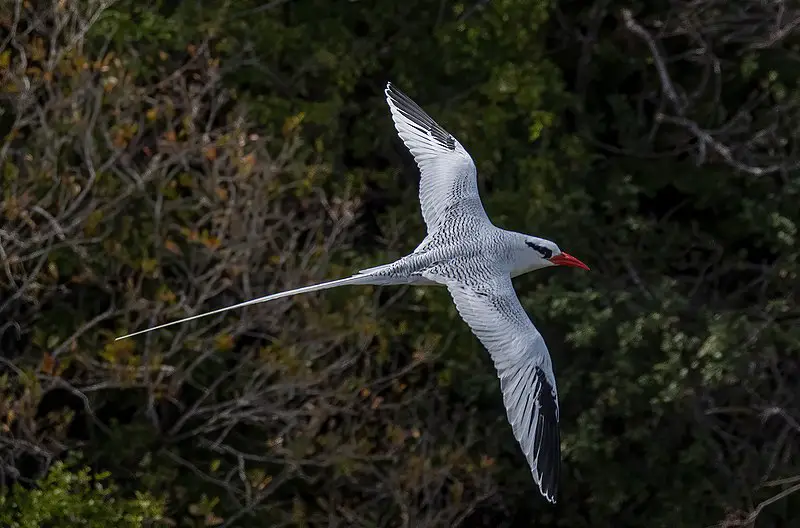
The Red-billed Tropicbird is a beautiful seabird found in tropical oceans. It has mainly white plumage, with black markings on its wings and back, along with a black mask and red bill.
These birds have distinctive long tail streamers that are twice their body length which they use to help them soar above the ocean surface while searching for food.
They primarily feed off squid, fish and crustaceans that inhabit coral reefs or deep sea areas where they can dive up to 30 meters below the water’s surface.
The Red-billed Tropicbird was once thought of as an omen of bad luck but now it serves as a reminder of how delicate our marine ecosystems are when faced with human activity such as overfishing.Scientific classification:
| Kingdom | Animalia |
| Phylum | Chordata |
| Class | Aves |
| Order | Phaethontiformes |
| Family | Phaethontidae |
| Genus | Phaethon |
| Species | P. aethereus |
Also Featured In: Native Pakistani Birds, Galapagos Birds You Should Know
2. Neotropic Cormorant
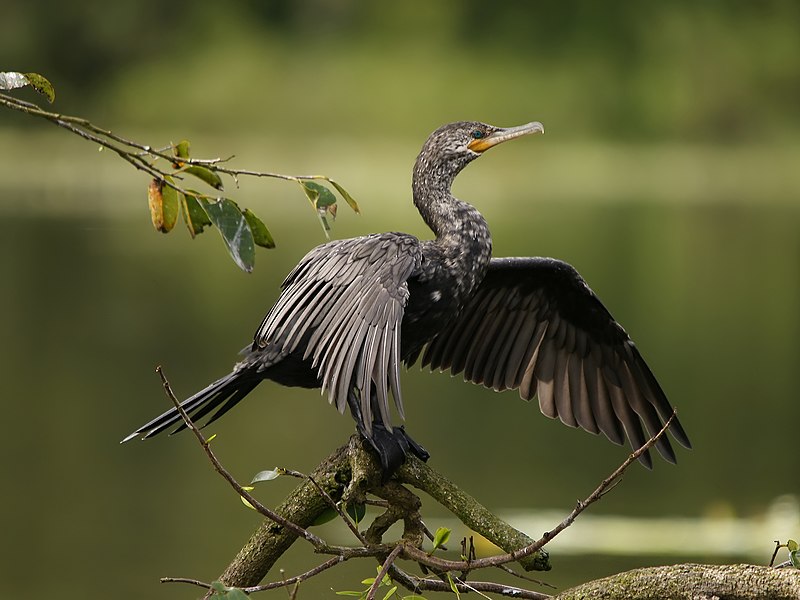
The Neotropic Cormorant, also known as the Olivaceous Cormorant, is a medium-sized bird found in tropical and subtropical regions of Central America, South America and the United States.
It can be identified by its black body with bright yellow facial skin on both sides of its large bill. The tail feathers are short and squared off at the tip.
This species breeds mainly on coasts but will sometimes nest inland near rivers or lakes during certain parts of their life cycle.
They feed mostly on small fish caught while diving underwater but can also eat crustaceans, amphibians and insects.
These birds roost in trees at night to keep safe from predators like foxes which prey upon them when they sleep close to water sources during daylight hours.Scientific classification:
| Kingdom | Animalia |
| Phylum | Chordata |
| Class | Aves |
| Order | Suliformes |
| Family | Phalacrocoracidae |
| Genus | Nannopterum |
| Species | N. brasilianum |
Also Featured In: Beautiful Brazilian Birds, Rainforest Birds You Should Know
3. Amazon Kingfisher
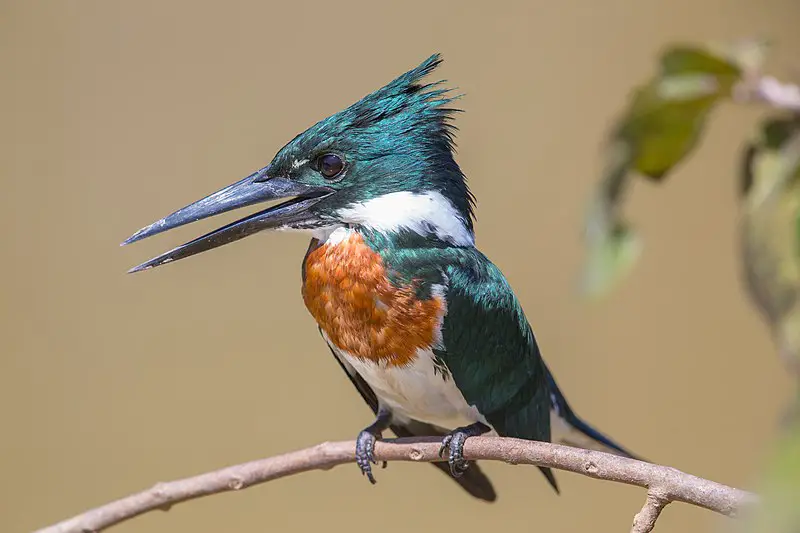
The Amazon Kingfisher is a stunning species of water kingfisher found in the lowlands of Central and South America.
It has an aqua-green head, chestnut wings with white markings, blue back and tail and yellow feet.
Its dramatic plumage makes it one of the most attractive birds in its region.
The Amazon Kingfisher can be seen perching on branches or flying close to slow moving rivers while they search for food such as fish, frogs, lizards or insects which they catch by diving into the water from above.
Despite their colorful appearance these bird are incredibly shy so it’s difficult to get too close without scaring them away.Scientific classification:
| Kingdom | Animalia |
| Phylum | Chordata |
| Class | Aves |
| Order | Coraciiformes |
| Family | Alcedinidae |
| Subfamily | Cerylinae |
| Genus | Chloroceryle |
| Species | C. amazona |
Also Featured In: Birds That Live in the Jungle, Common Tropical Rainforest Birds
4. Golden-Cheeked Woodpecker
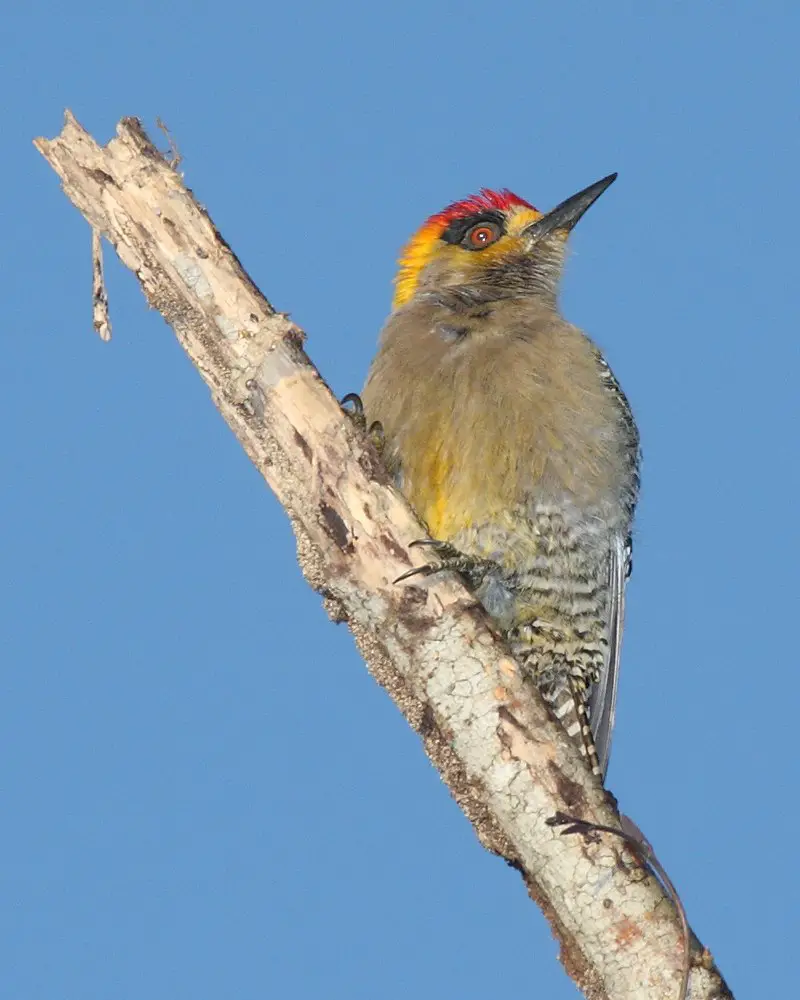
The Golden-cheeked Woodpecker is a unique species of bird found in Mexico. This beautiful creature has golden cheeks and chestnut plumage, with the male sporting a bright red crown on its head.
Endemic to the Pacific coastal strip from Sinaloa to Colima, it can also be seen inhabiting areas along the western mountain slopes of Trans-Mexican Volcanic Belt.
It prefers subtropical or tropical dry forests as their natural habitat where they search for food such as insects and larvae that are hidden deep inside tree trunks and branches.
The Golden-cheeked Woodpecker is an important part of Mexican wildlife which needs protection if we want this species to survive for future generations.Scientific classification:
| Kingdom | Animalia |
| Phylum | Chordata |
| Class | Aves |
| Order | Piciformes |
| Family | Picidae |
| Genus | Melanerpes |
| Species | M. chrysogenys |
Also Featured In: Top Birds Found in Mexico,
5. Inca Dove
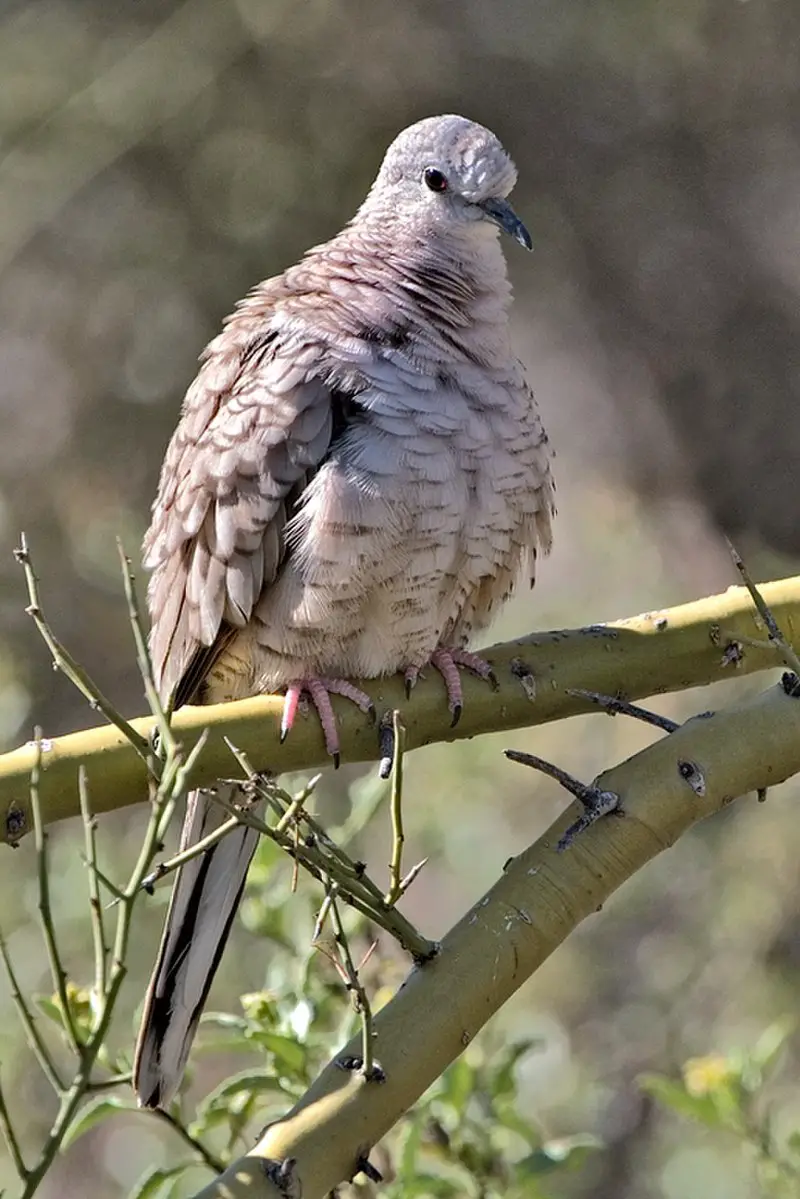
The Inca Dove is a small, slender bird found in the New World. It has an average length of 16.5–23 cm and weighs about 30-58 gm. Its wingspan measures around 28.5cm but can reach up to 32cm at max.
The body of this dove is grayish brown with feathers that are rounded off tips giving it a soft look overall.
This species was first described by French surgeon and naturalist René Lesson back in 1847 and since then have been living happily all over North America from Mexico through Texas to South Dakota, Kansas as well as parts of Arizona among others regions too.Scientific classification:
| Kingdom | Animalia |
| Phylum | Chordata |
| Class | Aves |
| Order | Columbiformes |
| Family | Columbidae |
| Genus | Columbina |
| Species | C. inca |
Also Featured In: Birds You’ll Find in the Rio Grande Valley, Most Common Birds of Nuevo Leon
6. West Mexican Chachalaca
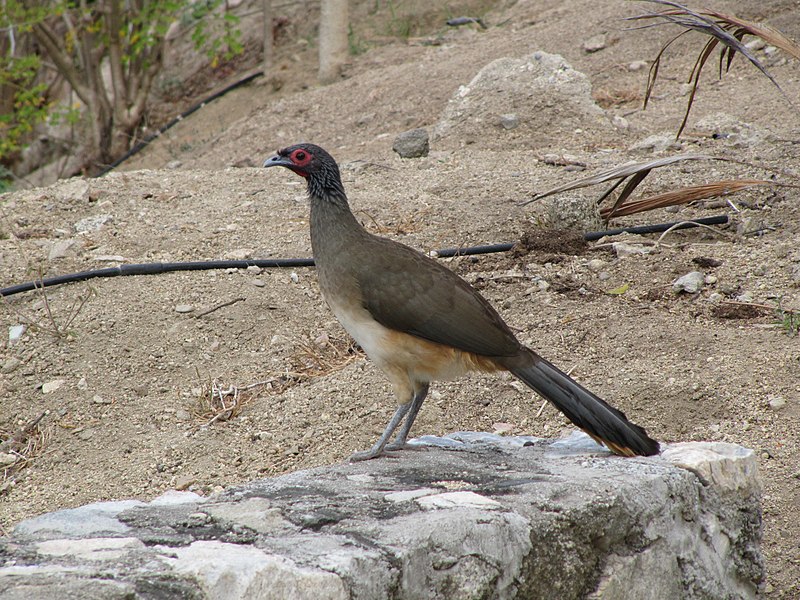
The West Mexican chachalaca is a species of bird from the family Cracidae found in Mexico. It was initially described as Penelope poliocephala and later moved to genus Ortalis.
At one time, it was considered a subspecies of plain chachalaca (Ortalis vetula). The West Mexican Chachalaca has slate-grey plumage with blackish wings and tail feathers that are bordered above by white stripes.
Its head is adorned with an orange tufted crest, while its bill is yellow or greenish-yellow coloured on top and grey underneath.
This medium size bird feeds mainly on fruits and insects but also consumes flowers, leaves & bark occasionally.
They live in small flocks in forests near rivers or humid areas close to mountains ranging between 500m – 3000m elevation up northwards into the Sierra Madre Occidental region of northern Mexico where they can be seen foraging during early mornings before flying off singly at dusk back towards their roosting sites amongst trees inside dense woods.Scientific classification:
| Kingdom | Animalia |
| Phylum | Chordata |
| Class | Aves |
| Order | Galliformes |
| Family | Cracidae |
| Genus | Ortalis |
| Species | O. poliocephala |
7. Russet-Crowned Motmot
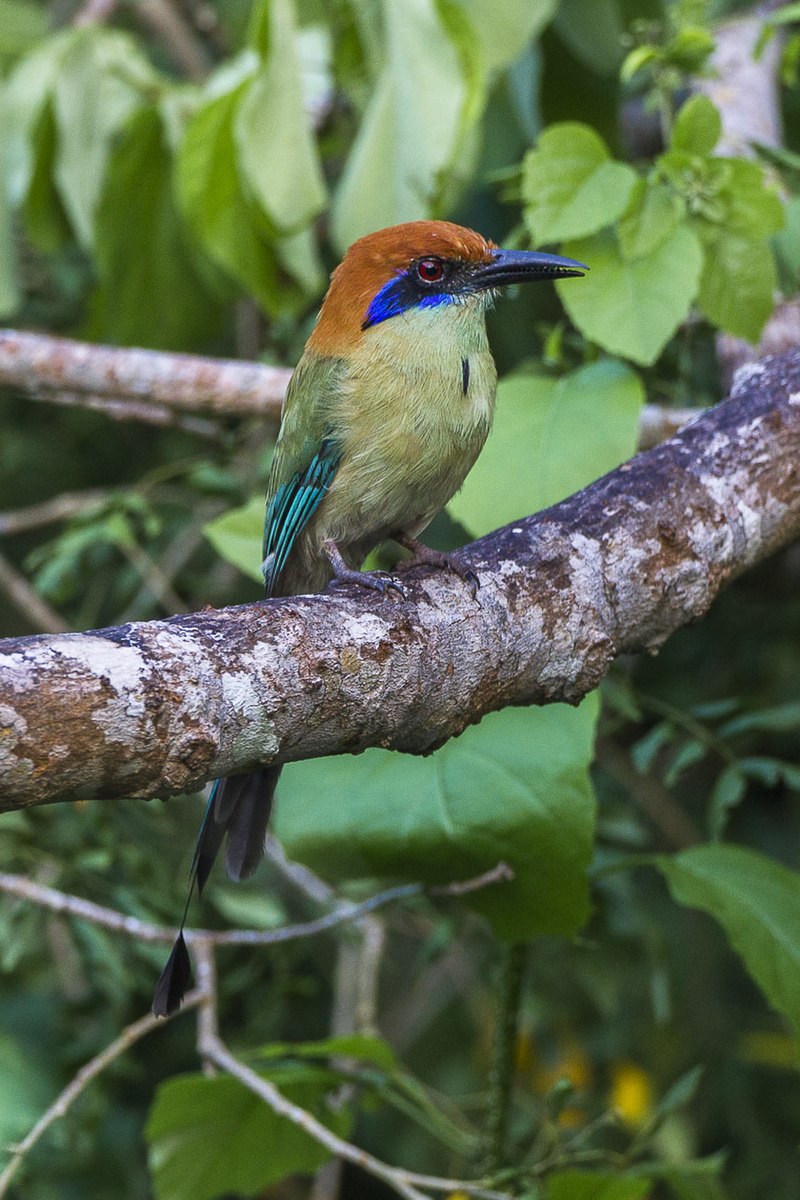
The Russet-crowned Motmot is an exotic species of bird native to north-western Mexico and central Guatemala. It is a year round resident in tropical dry broadleaf forests, scrubland and other areas with plentiful vegetation.
This type of motmots are easily identified by their reddish-brown crest on top of their heads which gives them the name ‘russet’ crowns.
These birds have also been observed displaying unique behaviors such as “bill-wagging” where they will move their bills from side to side while perched atop branches or trees.
They can be found eating insects, reptiles, amphibians, fruits and occasionally small mammals like mice or bats.
The russet crowned motmot population has declined due to deforestation but conservation efforts are helping protect this beautiful creature so that future generations may enjoy it’s majestic beauty for years to come.Scientific classification:
| Kingdom | Animalia |
| Phylum | Chordata |
| Class | Aves |
| Order | Coraciiformes |
| Family | Momotidae |
| Genus | Momotus |
| Species | M. mexicanus |
Also Featured In: Birds that Live in Morelos,
8. White-Faced Ibis
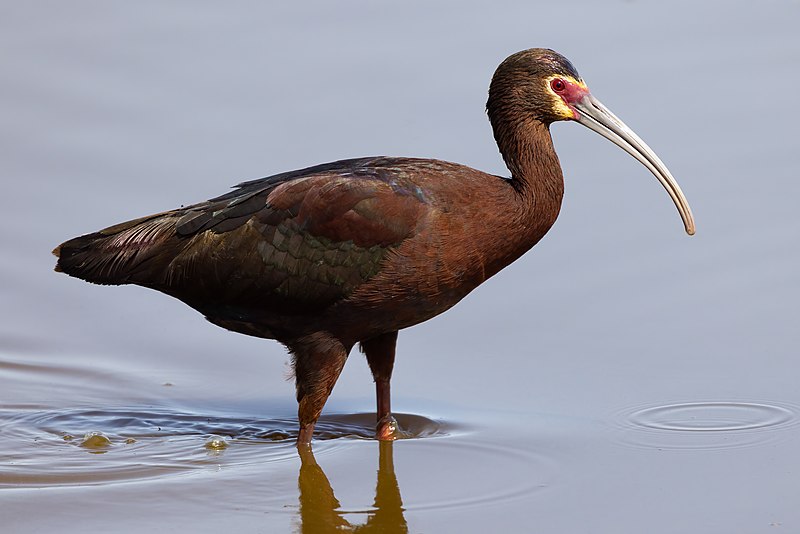
The White-faced Ibis is a species of wading bird belonging to the ibis family. It breeds in marshes, nesting on low trees or bushes.
The breeding range for this species stretches from western United States south through Mexico, and from southeastern Brazil and Bolivia all the way down to central Argentina and along the coast of Chile.
Its wintering grounds include coastal California, northern Arizona, New Mexico as well as Central America; it also occasionally occurs further north than usual due to favorable conditions.
This beautiful bird has white plumage with bronze wings that shine when seen under sunlight. Furthermore, its head is adorned by an unmistakable white face patch which gives it its name—White-faced Ibis.Scientific classification:
| Kingdom | Animalia |
| Phylum | Chordata |
| Class | Aves |
| Order | Pelecaniformes |
| Family | Threskiornithidae |
| Genus | Plegadis |
| Species | P. chihi |
Also Featured In: Water Birds Live around Us, Common Birds of Antelope Island State Park
9. Grey-Breasted Woodpecker
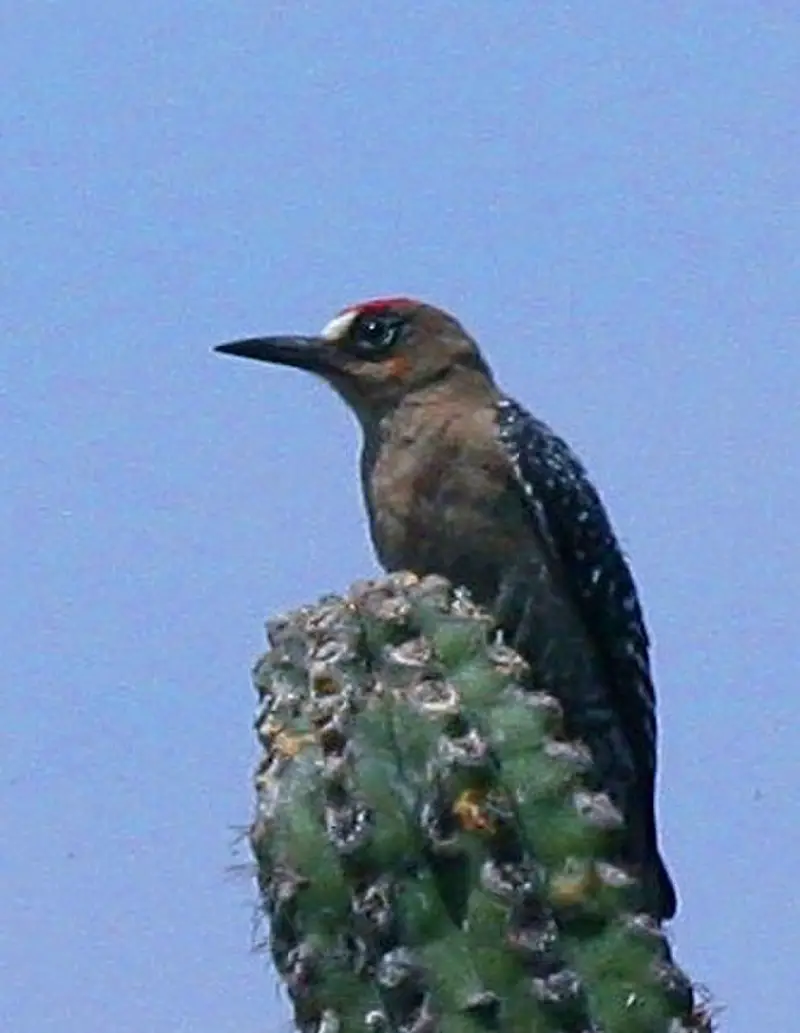
The Grey-breasted Woodpecker is a species of bird endemic to the interior of southwestern Mexico. Found in Guerrero, Morelos and Puebla, this elusive creature remained largely unknown until 1990 when a study conducted by the Cooper Ornithological Society revealed some fascinating insights into its behavior.
The birds were observed foraging on dead wood or tree trunks as well as cavities created by other woodpeckers; with their greyish brown plumage they have adapted perfectly to their arid environment.
They are also known for excavating nest cavities in trees and cacti where females lay two white eggs. A conservation effort should be made to protect these majestic creatures whose numbers could potentially decline if left unchecked due to habitat loss or illegal poaching activities.Scientific classification:
| Kingdom | Animalia |
| Phylum | Chordata |
| Class | Aves |
| Order | Piciformes |
| Family | Picidae |
| Genus | Melanerpes |
| Species | M. hypopolius |
10. Long-Tailed Wood Partridge
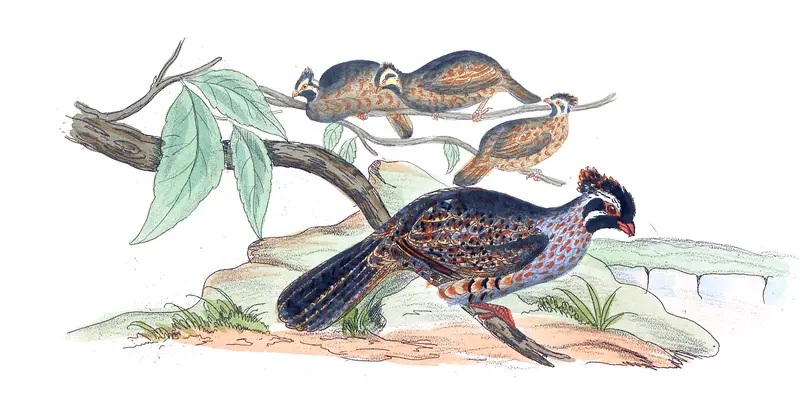
The Long-tailed Wood Partridge is a species of bird found only in Mexico, belonging to the family Odontophoridae.
It has six subspecies and measures 11.4 – 16.6 inches (29 – 42 cm) long with its namesake long tail accounting for almost two thirds of that length.
Its plumage is mostly greyish brown but can range from purple through chestnut red to olive green depending on its location and time of year.
This partridge does not migrate nor live in flocks as other quail do, instead living alone or in pairs near forest edges where there are plenty of low bushes for cover against predators such as foxes and coyotes which it will hide from if disturbed by running into thick vegetation or flying short distances away from them when possible.Scientific classification:
| Kingdom | Animalia |
| Phylum | Chordata |
| Class | Aves |
| Order | Galliformes |
| Family | Odontophoridae |
| Genus | Dendrortyx |
| Species | D. macroura |
Also Featured In: Common Birds of Mexico City,
11. Ruddy Ground Dove
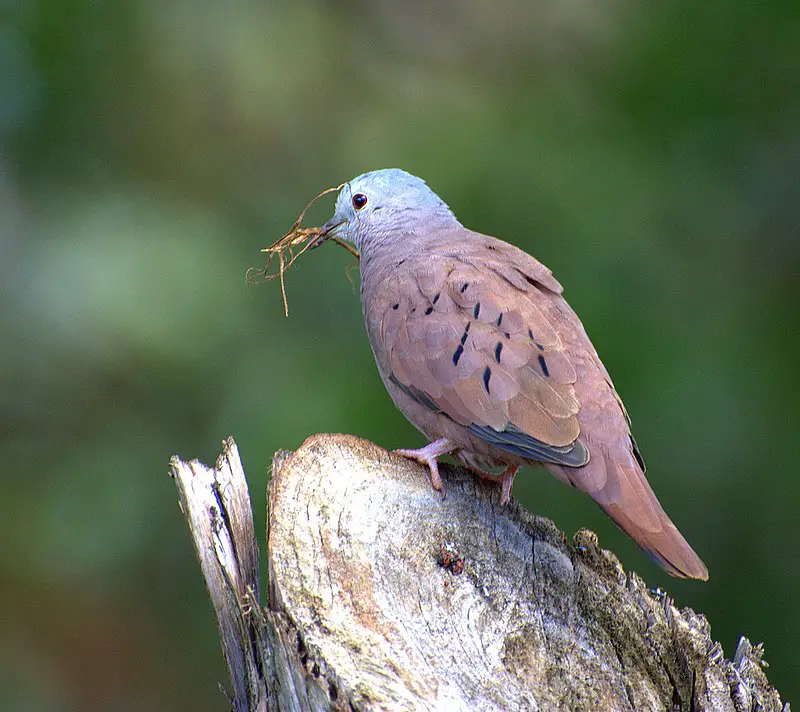
The Ruddy Ground Dove is a small New World tropical bird, found across Mexico and South America as far south as Argentina. It is also seen in the southwestern United States during winter months.
This ground dove typically lives in scrub or other open habitats such as savannas and grasslands, where it feeds on seeds from plants like cactus fruits.
Its plumage ranges from grey to reddish-brown with a light tan breast and black markings throughout its wings and tail feathers.
The male has more distinguishable colouration than the female but both sexes have bright red eyes which give this species its name – ‘ruddy’.
They are often observed perching low to the ground near food sources or nesting sites while also being quite vocal when flying between locations making them easier to spot.Scientific classification:
| Kingdom | Animalia |
| Phylum | Chordata |
| Class | Aves |
| Order | Columbiformes |
| Family | Columbidae |
| Genus | Columbina |
| Species | C. talpacoti |
Also Featured In: Most Common Birds in South America Birds,
12. Lesser Yellowlegs
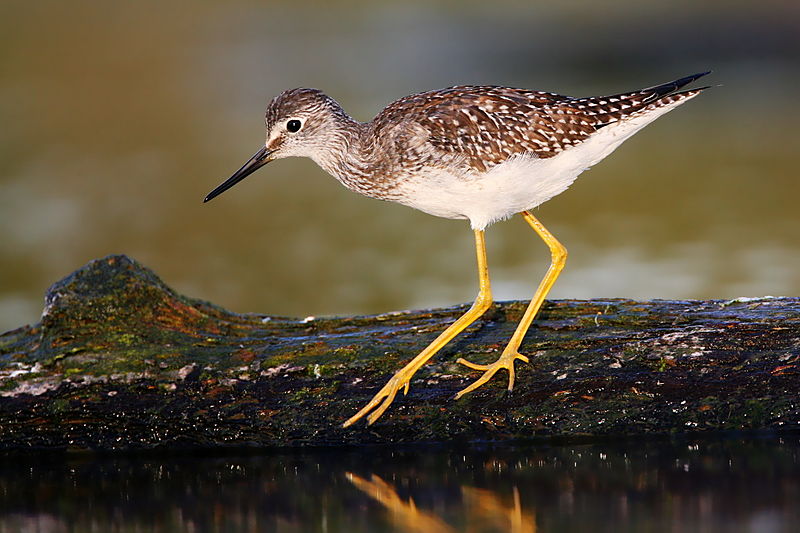
The Lesser Yellowlegs is a medium-sized shorebird found in the boreal forest region of North America.
It was described by German naturalist Johann Friedrich Gmelin in 1789 and placed it into the genus Scolopax.
This species has buff upperparts, white underparts, yellow legs and feet, olive green wings with white edges on its secondaries and tertials as well as a thin black bill which curves downward towards its tip.
The male lesser yellowlegs are slightly larger than females and can be distinguished from other waders due to their unique call; they will often make loud “tchew” or “churr” noises when alarmed during breeding season.
They typically feed on small aquatic insects such as beetles, flies, moths etc., but may also eat crustaceans such as shrimp or water snails if available.Scientific classification:
| Kingdom | Animalia |
| Phylum | Chordata |
| Class | Aves |
| Order | Charadriiformes |
| Family | Scolopacidae |
| Genus | Tringa |
| Species | T. flavipes |
Also Featured In: Birds in Calgary You’ll Love to See, Common Birds in Prince Edward Island
13. Marbled Godwit
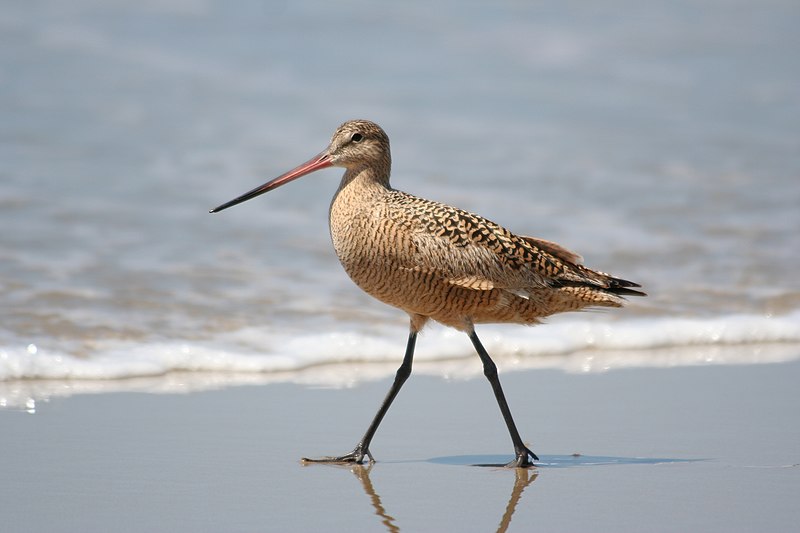
The Marbled Godwit is a large migratory shorebird in the Scolopacidae family and is one of the largest species amongst four godwits.
It was first described by English naturalist George Edwards in 1750, as ‘The Greater American Godwit’.
The bird has long legs and bill for probing mudflats for food. Their plumage varies from mottled gray to reddish or brown on their upperparts, with white underparts that contrast against it.
During breeding season they can be seen along northern prairies in North America and migrate south towards Mexico during winter months.
They are omnivorous feeders but prefer aquatic insects like crustaceans, larvae etc., which makes them an important element of wetland ecosystems across its range.Scientific classification:
| Kingdom | Animalia |
| Phylum | Chordata |
| Class | Aves |
| Order | Charadriiformes |
| Family | Scolopacidae |
| Genus | Limosa |
| Species | L. fedoa |
Also Featured In: Birds Live Near San Diego, Birds That Live In Humboldt Bay
14. Reddish Egret
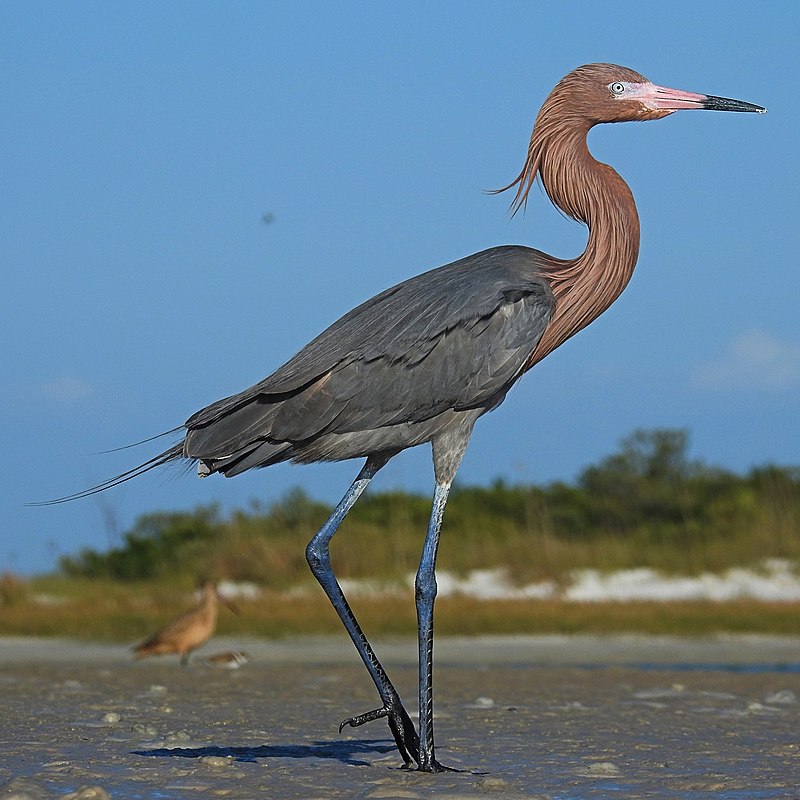
The Reddish Egret is a medium-sized heron that breeds in Central America, The Bahamas, the Caribbean, Texas and Mexico.
It prefers mud flats as its habitat of choice due to its unique foraging behaviour which differs from other herons.
In the past it was hunted widely for its feathers used to make fashionable hats but thankfully this practice has now been stopped.
They have white or grey plumage with pink legs and bill giving them their name.
These birds feed mainly on fish which they catch by making quick darting movements in shallow water or running rapidly through shallows stirring up prey so they can snatch them easily with their bills.
Their long wings enable them to fly quickly when hunting and also during migration season when many travel southwards towards warmer climates.Scientific classification:
| Kingdom | Animalia |
| Phylum | Chordata |
| Class | Aves |
| Order | Pelecaniformes |
| Family | Ardeidae |
| Genus | Egretta |
| Species | E. rufescens |
Also Featured In: Birds that Live around Southwest Florida, Blue Birds that You’ll Find in Utah
15. Brown Booby
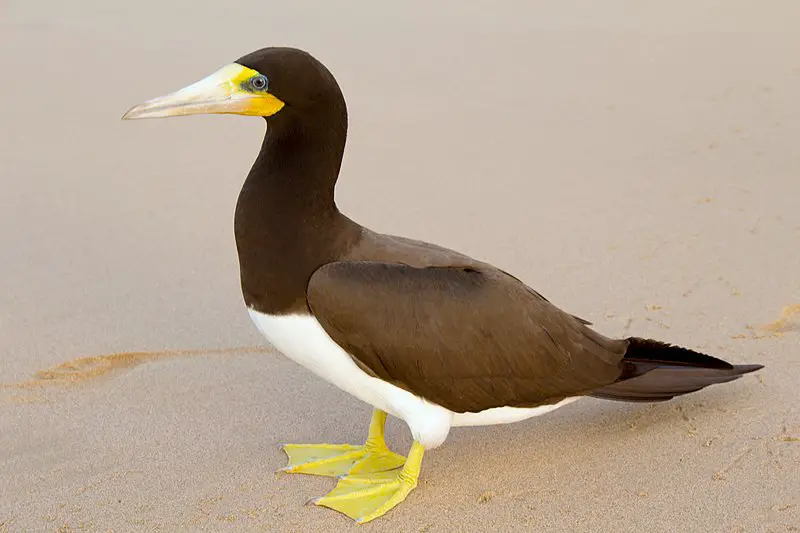
The Brown Booby is a large, seabird from the booby family Sulidae. It has a pantropical range and can be found in many areas of the world.
This bird lives in flocks and forages by plunging into shallow waters to catch small fish that are driven near the surface by predators or storms.
The brown booby is known for its short wings which make it highly maneuverable when hunting; this allows it to pursue prey quickly with sudden turns and dives.
Its diet also includes squid, crustaceans, eggs of other birds, as well as scraps from boats or ships they may come across while flying around coastlines.
They sometimes rest on floating objects during their long flights over open water between islands or continents.Scientific classification:
| Kingdom | Animalia |
| Phylum | Chordata |
| Class | Aves |
| Order | Suliformes |
| Family | Sulidae |
| Genus | Sula |
| Species | S. leucogaster |
Also Featured In: Egyptian Birds, Birds You’ll Find in the Sea
16. Ringed Kingfisher
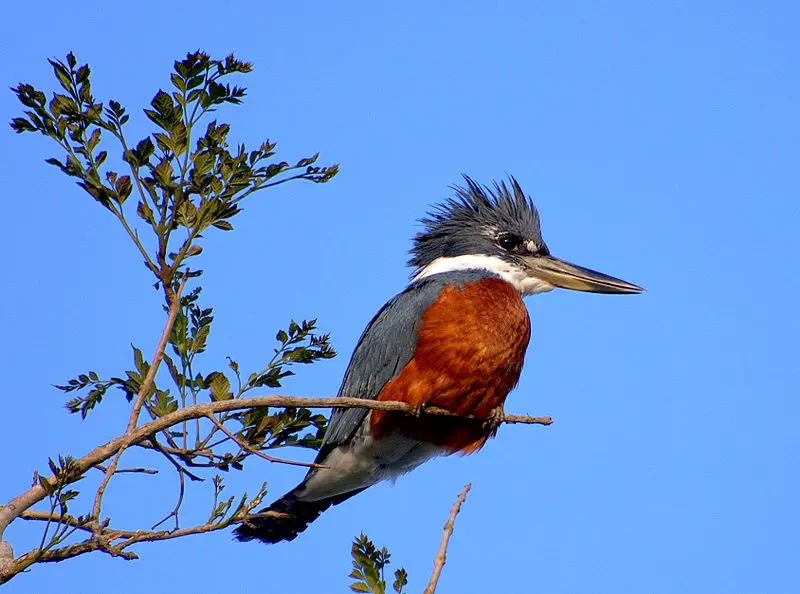
The Ringed Kingfisher is a large, vibrant bird that can be easily noticed by its loud call. It’s found in tropical regions from the lower Rio Grande Valley of southeastern Texas to Central America and even as far south as Tierra del Fuego.
This ground-dwelling species prefers to inhabit open areas near water bodies like streams, rivers and lakes which provide them with plenty of food such as fish, amphibians, crustaceans and insects.
In 1888 it was first identified by ornithologist Frank Chapman who noted its distinct ring pattern on the breast area.
The upperparts are dark blue while underneath they have white spots around their neck and belly region along with pale brown wings tipped in black stripes making this species quite unique among other kingfishers.
They may look intimidating but these birds actually play an important role for humans since they help control insect populations thus helping maintain a healthy balance within our ecosystems.Scientific classification:
| Kingdom | Animalia |
| Phylum | Chordata |
| Class | Aves |
| Order | Coraciiformes |
| Family | Alcedinidae |
| Subfamily | Cerylinae |
| Genus | Megaceryle |
| Species | M. torquata |
Also Featured In: Common Birds in Colombia, Birds that Live in Guyana
17. Groove-Billed Ani
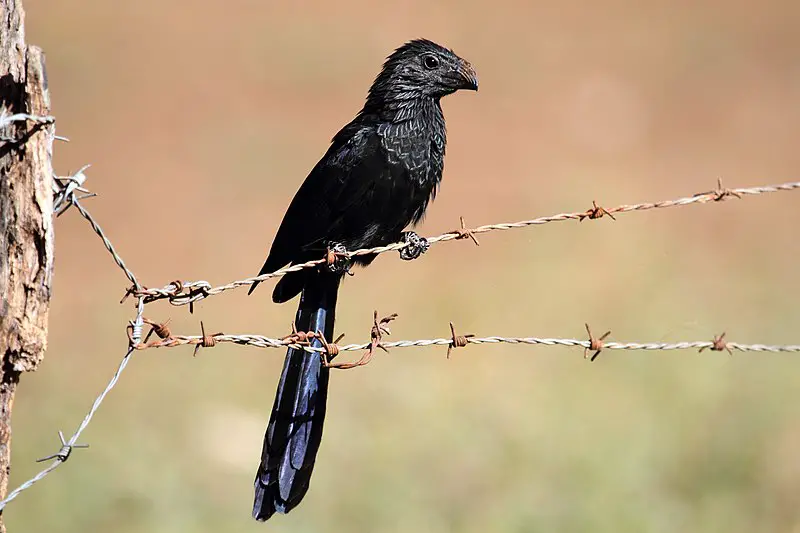
The Groove-billed ani is a tropical bird belonging to the cuckoo family. It has a long tail and large, curved beak.
This species can be found in many parts of Central America, from southern Texas to northern Colombia and Venezuela, as well as coastal Ecuador and Peru.
In some places it may retreat during colder months but overall they are considered resident birds throughout their range.
They prefer open woodlands near water sources like mangroves or swamps where there plenty of insects for them to feed on such as grasshoppers and beetles.
The beautiful coloration of this species ranges from blackish brown with orange spots on its wings that give way to bright blue feathers at the end of its tail making it quite striking.Scientific classification:
| Kingdom | Animalia |
| Phylum | Chordata |
| Class | Aves |
| Order | Cuculiformes |
| Family | Cuculidae |
| Genus | Crotophaga |
| Species | C. sulcirostris |
Also Featured In: Most Unique Birds in Peru, Birds that Live in the Grand Canyon National Park
18. Green Kingfisher
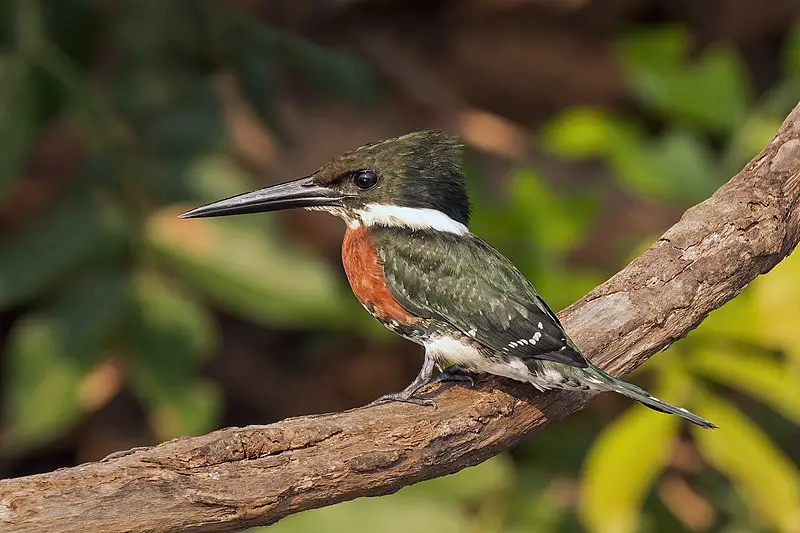
The Green Kingfisher is an incredibly vibrant bird, boasting a bright green plumage and long beak.
It can primarily be found throughout Central America, in most South American countries except Chile, as well as Texas in the United States and Trinidad & Tobago.
This species of water kingfisher belongs to subfamily Cerylinaeof family Alcedinidae which was first described by German naturalist Johann Friedrich Gmeiner back in 1788.
The Green Kingfishers are known for their active hunting habits where they perch above shallow waters looking out for prey such as small fish or crustaceans before diving down rapidly into the water with a loud splash.Scientific classification:
| Kingdom | Animalia |
| Phylum | Chordata |
| Class | Aves |
| Order | Coraciiformes |
| Family | Alcedinidae |
| Subfamily | Cerylinae |
| Genus | Chloroceryle |
| Species | C. americana |
Also Featured In: Most Common Birds Found in Chile, Green Birds in That Live in Texas
19. Berylline Hummingbird
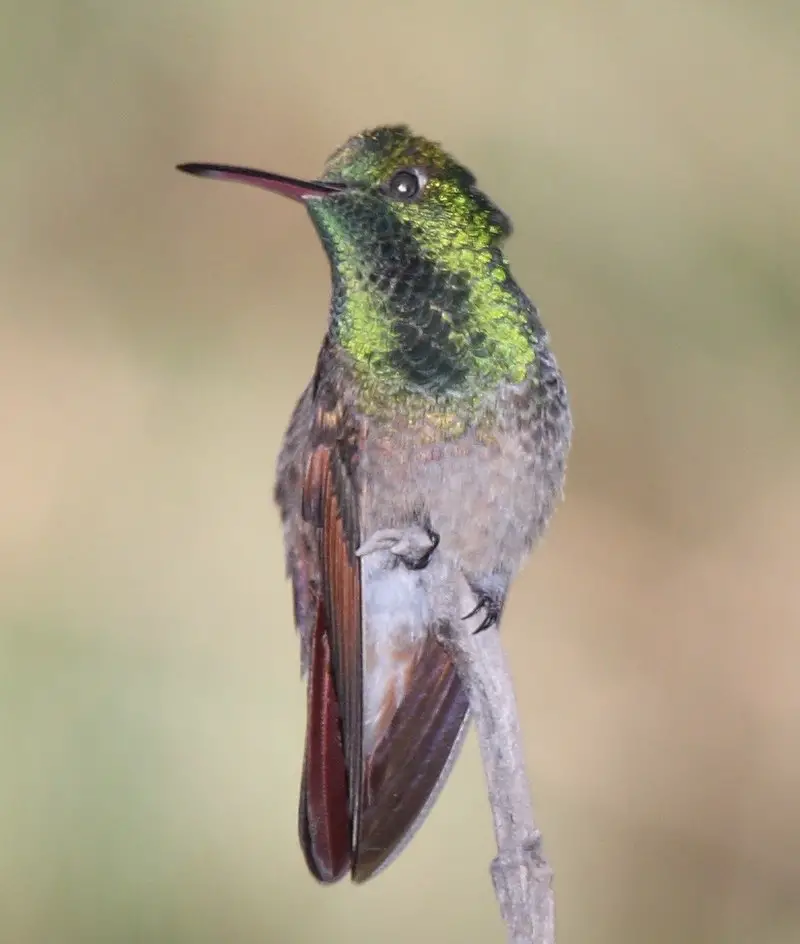
The Berylline Hummingbird is a vibrant species of hummingbird found in Central America and the United States.
It has emerald green upperparts, rufous sides and underparts, white tips to its tail feathers, as well as an iridescent purple throat patch.
These birds are highly territorial and will defend their territories against intruders with impressive aerial displays.
They feed on nectar from flowers such as bromeliads, columbines or agaves while searching for insects which they catch mid-air by hovering near foliage or flying low over meadows.
The Berylline Hummingbird is considered a Least Concern species due to its wide distribution range but it faces threats from habitat loss caused by urbanization and farming practices that reduce suitable nesting sites available for this bird.Scientific classification:
| Kingdom | Animalia |
| Phylum | Chordata |
| Class | Aves |
| Order | Apodiformes |
| Family | Trochilidae |
| Genus | Saucerottia |
| Species | S. beryllina |
Also Featured In: Most Beautiful Birds in Guatemala,
20. Northern Jacana
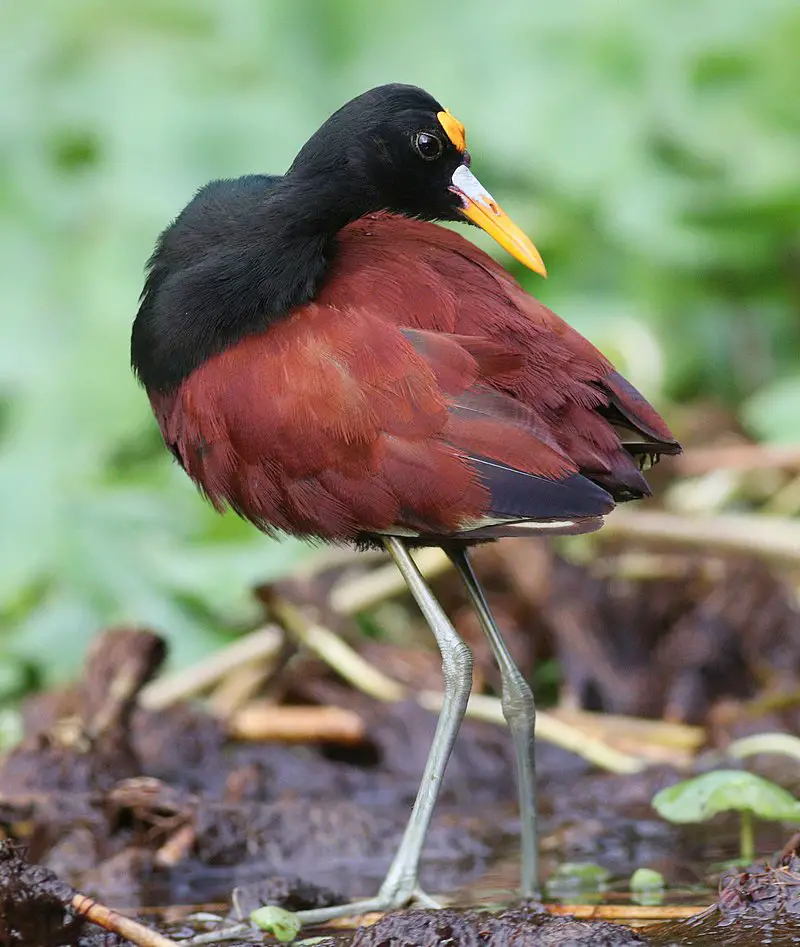
The Northern Jacana is a wading bird native to Mexico, Panama, Cuba, Jamaica and Hispaniola. It can also be found in Texas as a resident breeder or on rare occasions in Arizona as a vagrant.
This species of wetland birds are easily identified by their immense size and large feet with long toes that help them walk atop floating vegetation while searching for food.
Their upperparts have black feathers streaked with white whilst its underparts display brown plumage marked by yellowish spots near the wingtips.
They feed primarily on insects but will also eat other aquatic invertebrates like crustaceans or mollusks when available.
The female builds an untidy nest made from leaves close to water so she can quickly escape predators if needed.Scientific classification:
| Kingdom | Animalia |
| Phylum | Chordata |
| Class | Aves |
| Order | Charadriiformes |
| Family | Jacanidae |
| Genus | Jacana |
| Species | J. spinosa |
Also Featured In: Dominican Republic birds, Birds That You’ll Find in Hispaniola
21. White-Fronted Amazon
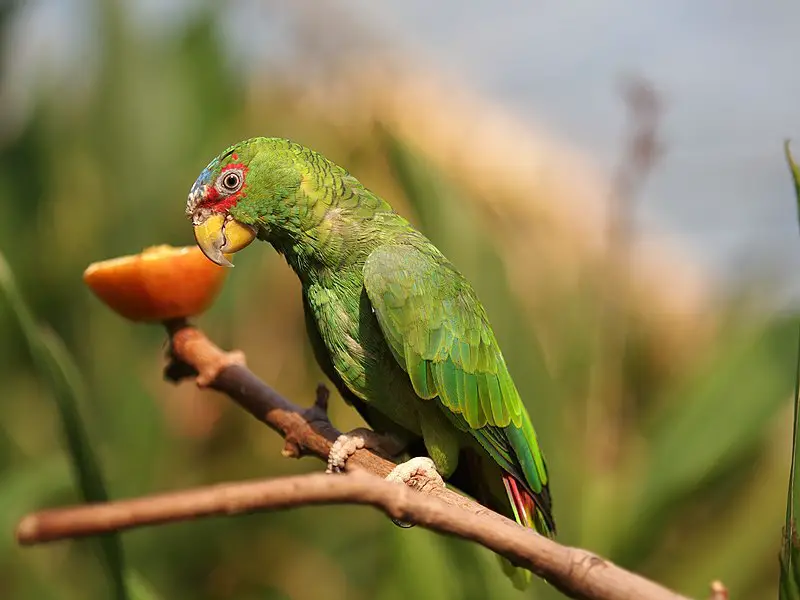
The white-fronted amazon is a Central American parrot that stands out for its bright colouring and ability to imitate around 40 different sounds.
It has an average life span of about 40 years, making it one of the longest living parrots in existence.
Despite being the smallest species among large parrots, measuring 25cm long, this bird still possesses strong vocal chords which can be heard from great distances.
They have beautiful yellow heads with distinctive white patches on their forehead and grey feathers covering their wings and tail.
These birds are very social animals who live in pairs or family groups within tropical rainforests and wetlands where they feed mostly on seeds found in trees such as palms.Scientific classification:
| Kingdom | Animalia |
| Phylum | Chordata |
| Class | Aves |
| Order | Psittaciformes |
| Family | Psittacidae |
| Genus | Amazona |
| Species | A. albifrons |
Also Featured In: Birds of Honduras,
22. Laughing Falcon
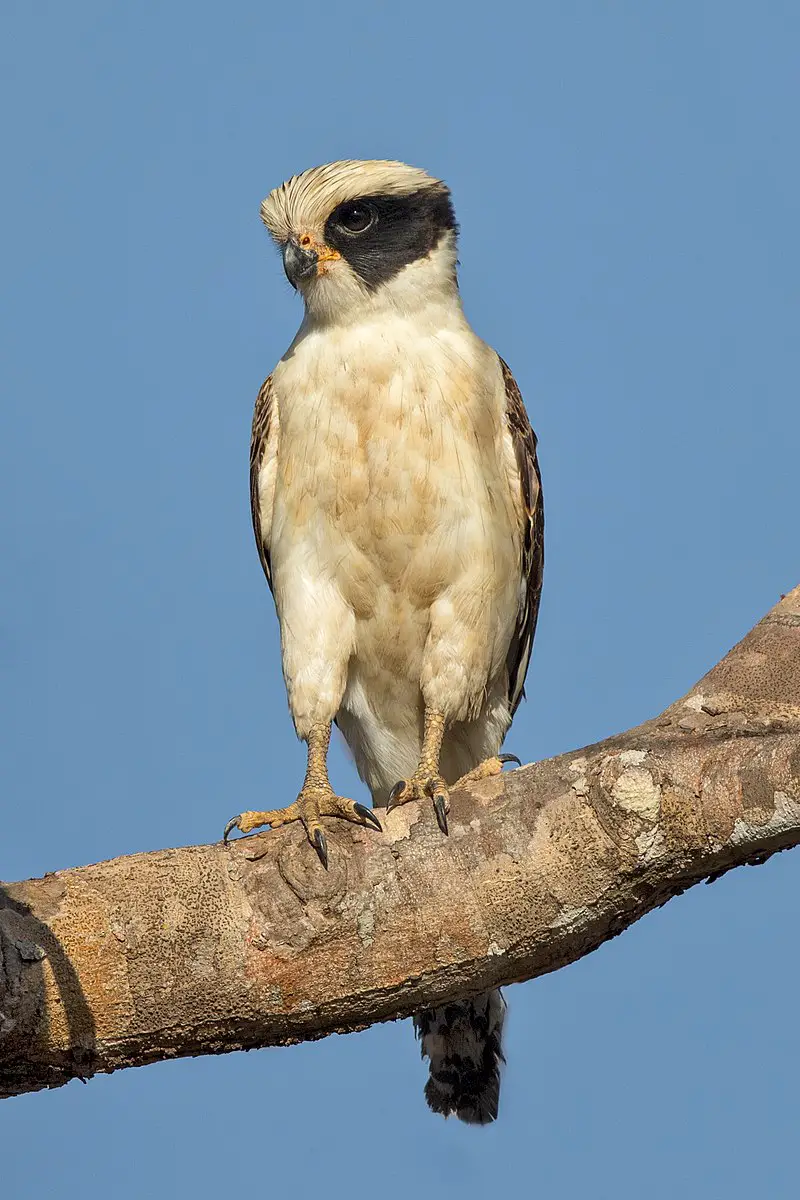
The Laughing Falcon is a medium-sized bird of prey belonging to the falcon family. It’s only member of its genus, Herpetotheres cachinnans, and got its name from it’s distinct loud voice.
This Neotropical species is known for being an expert snake eater. With sharp talons and powerful beak they are well equipped for hunting down snakes and lizards with ease.
Despite their fierce reputation they have a gentle side too; pairs usually mate for life while looking after their offspring together in harmony.
The Laughing Falcon should be admired rather than feared as this amazing creature has much more to offer than just hissing sound effects.Scientific classification:
| Kingdom | Animalia |
| Phylum | Chordata |
| Class | Aves |
| Order | Falconiformes |
| Family | Falconidae |
| Subfamily | Herpetotherinae |
| Genus | Herpetotheres Vieillot, 1817 |
| Species | H. cachinnans |
Also Featured In: Colorful Birds of Nicaragua,
23. Bare-Throated Tiger Heron
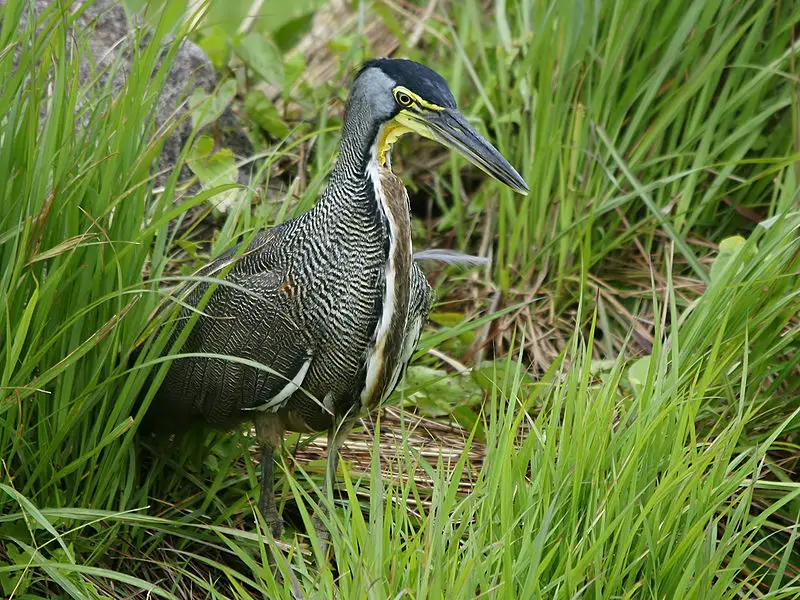
The Bare-throated Tiger Heron is an impressive wading bird belonging to the heron family, Ardeidae.
It has a length of 80 cm and weighs 1,200 grams. Found from Mexico to northwestern Colombia with one recorded sighting from the United States in Texas, it prefers more open habitats such as river and lake banks than other Tigrisoma herons.
Its plumage is blackish above with white spots on its back while its lower parts are chestnut brown or rufous in coloration.
The head and throat have bare yellow skin that can turn bright red when alarmed or during courtship displays.
Additionally, these birds feed mainly on fish but also eat amphibians, reptiles and aquatic insects which they capture by standing still before suddenly snatching them up.Scientific classification:
| Kingdom | Animalia |
| Phylum | Chordata |
| Class | Aves |
| Order | Pelecaniformes |
| Family | Ardeidae |
| Genus | Tigrisoma |
| Species | T. mexicanum |
24. Amethyst-Throated Mountaingem
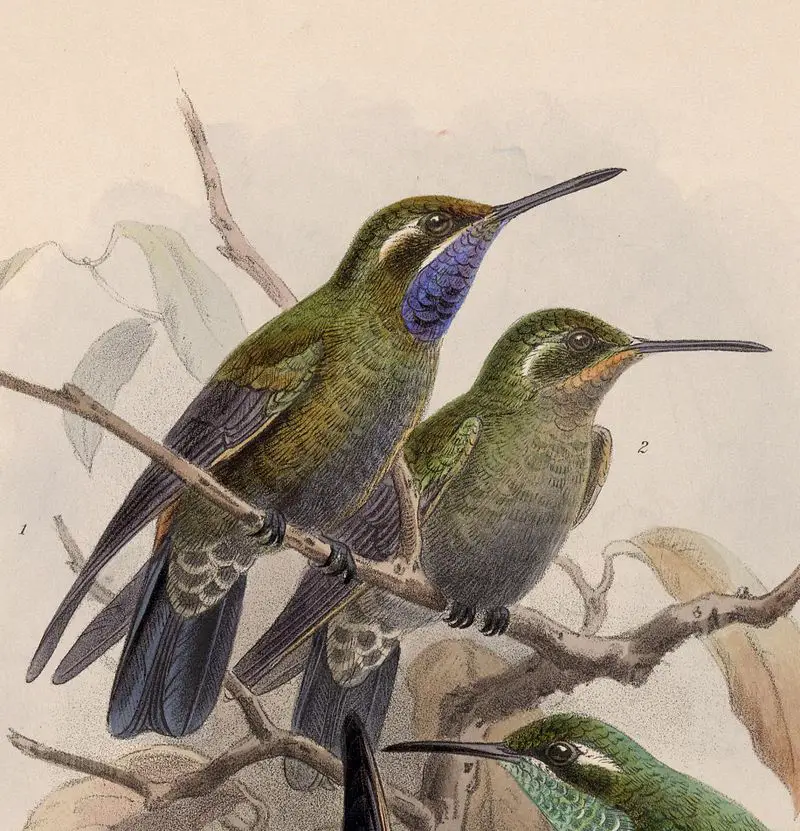
The Amethyst-throated Mountaingem is a species of hummingbird that can be found in El Salvador, Guatemala, Honduras and Mexico.
It has five subspecies and it’s size ranges from 11.5 to 12.5 cm long with males typically being larger than the females.
They have green upper parts with patches of blue on their back as well as an amethyst colored throat patch which gives them their name.
These birds are nectarivores meaning they feed mainly on flower nectar supplemented by small insects like spiders or other invertebrates caught while hovering over foliage or flying low near vegetation in search for food sources such as flowers or fruits offering high energy content items like agave syrup produced by some types of cacti during blooming season.Scientific classification:
| Kingdom | Animalia |
| Phylum | Chordata |
| Class | Aves |
| Order | Apodiformes |
| Family | Trochilidae |
| Genus | Lampornis |
| Species | L. amethystinus |
Also Featured In: El Salvador Birds,
25. Social Flycatcher
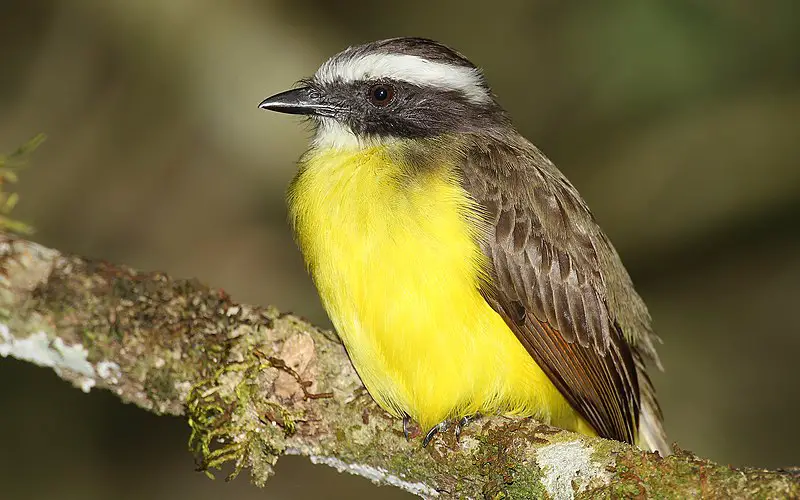
The Social Flycatcher is a medium-sized passerine bird from the Americas, belonging to the large tyrant flycatcher family.
It has often been split into two species – Myiozetetes texensis and Myiozetetes similis proper – due to its distinct range across Costa Rica northwards to Mexico and southward towards South America respectively.
This bird sports dark grey upperparts combined with white underparts, along with a vermilion crown on its head.
It also possesses an upright posture when perched which makes it easily recognizable in comparison with other birds of similar size within its habitat.
The social flycatcher feeds mainly on insects but can sometimes supplement these meals by eating fruits as well.Scientific classification:
| Kingdom | Animalia |
| Phylum | Chordata |
| Class | Aves |
| Order | Passeriformes |
| Family | Tyrannidae |
| Genus | Myiozetetes |
| Species | M. similis |
Also Featured In: Costa Rica Birds,
26. Plain-Capped Starthroat
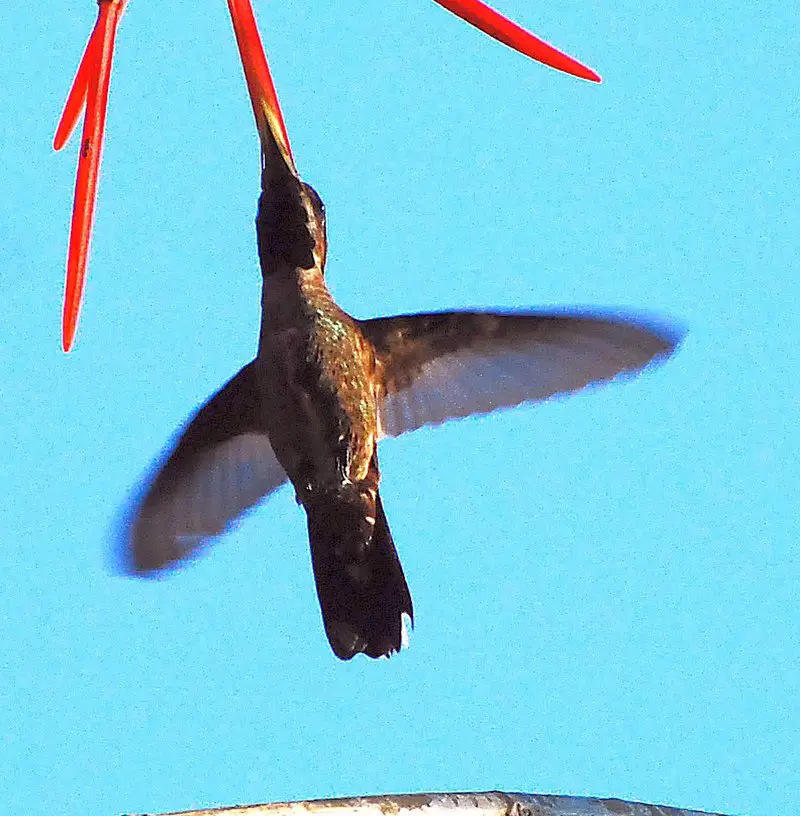
The Plain-capped Starthroat is a species of hummingbird found in Mexico to Costa Rica.
It has three subspecies, the nominate H. c. constantii, H. c. pinicola, and H. c. leocadiae which are all about 11 – 13 cm long and males weigh around 6 grams while females 5 grams on average.
The male’s most striking feature is its glossy blue gorget with an orange central spot surrounded by two white spots that give it the look of a star throat patch; this can be seen when it flies or sings at high pitch from common perches like bushes, trees or wires.
While they mainly feed on nectar from flowers they also occasionally hunt insects for protein supplementing their diet.Scientific classification:
| Kingdom | Animalia |
| Phylum | Chordata |
| Class | Aves |
| Order | Apodiformes |
| Family | Trochilidae |
| Genus | Heliomaster |
| Species | H. constantii |
27. Boat-Billed Heron
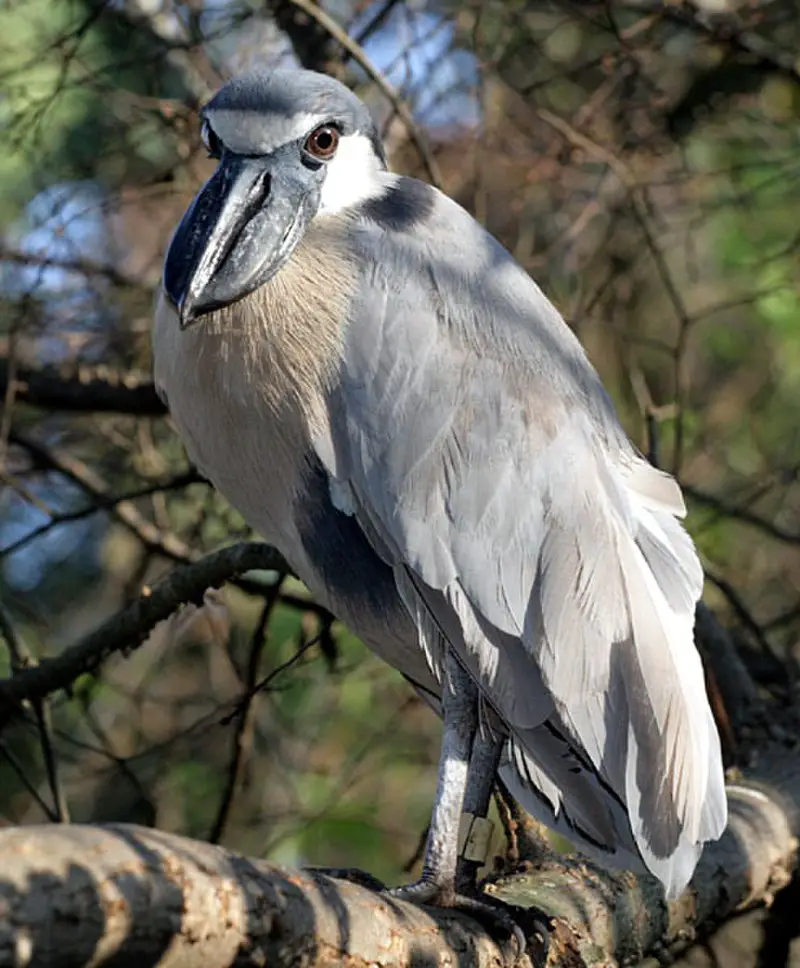
The Boat-billed Heron is a unique member of the heron family, living in mangrove swamps from Mexico to Peru and Brazil. It has an atypical bill shape compared to other members of its family which gives it its name.
Due to its nocturnal behavior, this bird breeds semi-colonially in mangrove trees during the night and lays two to four blue eggs per clutch that take around three weeks for incubation.
This species also exhibits some interesting hunting techniques such as spreading out its wings while standing still on branches or even submerging itself partially into water until prey passes by within reach; so they can snatch them quickly with their long beaks.
Conservation efforts must continue due to threats posed by habitat loss and human disturbance.Scientific classification:
| Kingdom | Animalia |
| Phylum | Chordata |
| Class | Aves |
| Order | Pelecaniformes |
| Family | Ardeidae |
| Subfamily | Tigriornithinae |
| Genus | Cochlearius Brisson, 1760 |
| Species | C. cochlearius |
28. Grey-Breasted Martin
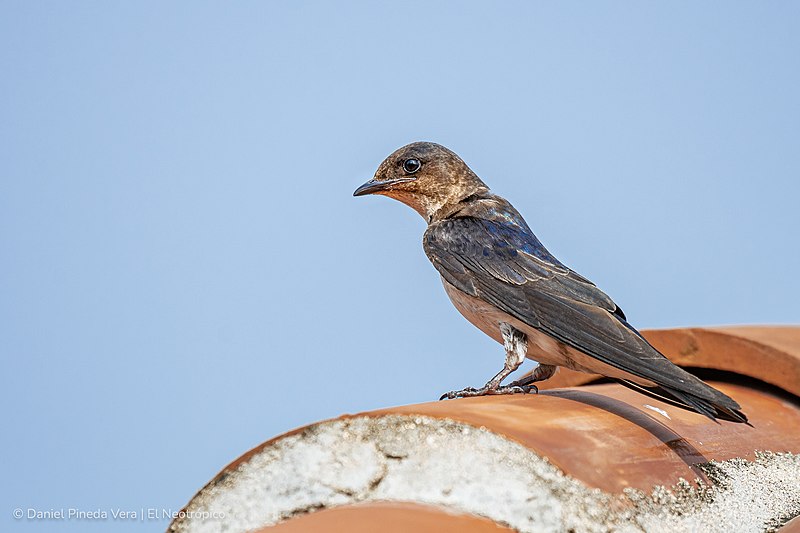
The grey-breasted martin is a large swallow species, native to Central and South America. It has several subspecies, with some migrating north as far as Venezuela during the southern hemisphere’s winter season.
Adults of this species are 18cm long and have forked tails. They mainly feed on insects in open habitats such as savannas or grasslands, but can also be seen near human settlements or agricultural areas.
The birds usually build their nests under bridges or other man-made structures like eaves of buildings or porches where they stay safe from predators.
Grey-breasted martins form monogamous pairs that remain together throughout the year; both male and female take part in nest building activities along with feeding young ones once hatched out of eggs laid by females alone typically laying three to four white eggs per clutch..Scientific classification:
| Kingdom | Animalia |
| Phylum | Chordata |
| Class | Aves |
| Order | Passeriformes |
| Family | Hirundinidae |
| Genus | Progne |
| Species | P. chalybea |
Also Featured In: Uruguay birds,
29. Zone-Tailed Hawk
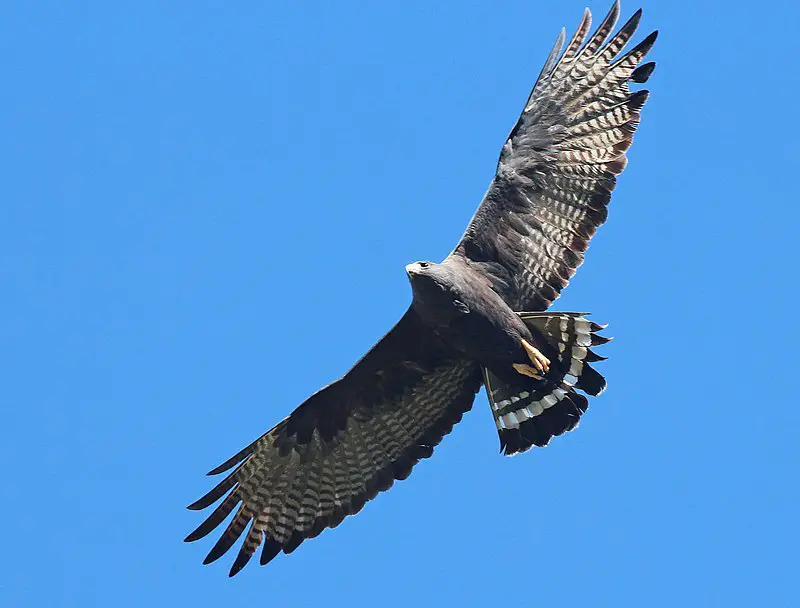
The Zone-tailed Hawk is a medium-sized bird found in warm and dry areas of the Americas. It has similar plumage to that of a turkey vulture, allowing it to blend into groups for camouflage.
Its diet consists mostly of small tetrapods such as mammals, reptiles or amphibians.
First described by George Robert Gray in 1844, this species can be identified by its greyish brown upperparts and wings with black barring on the tail feathers which are white underneath.
During flight they soar gracefully thanks to their rounded wings while keeping an eye out for prey below them.Scientific classification:
| Kingdom | Animalia |
| Phylum | Chordata |
| Class | Aves |
| Order | Accipitriformes |
| Family | Accipitridae |
| Genus | Buteo |
| Species | B. albonotatus |
Also Featured In: Trinidad and Tobago birds,
30. Masked Booby
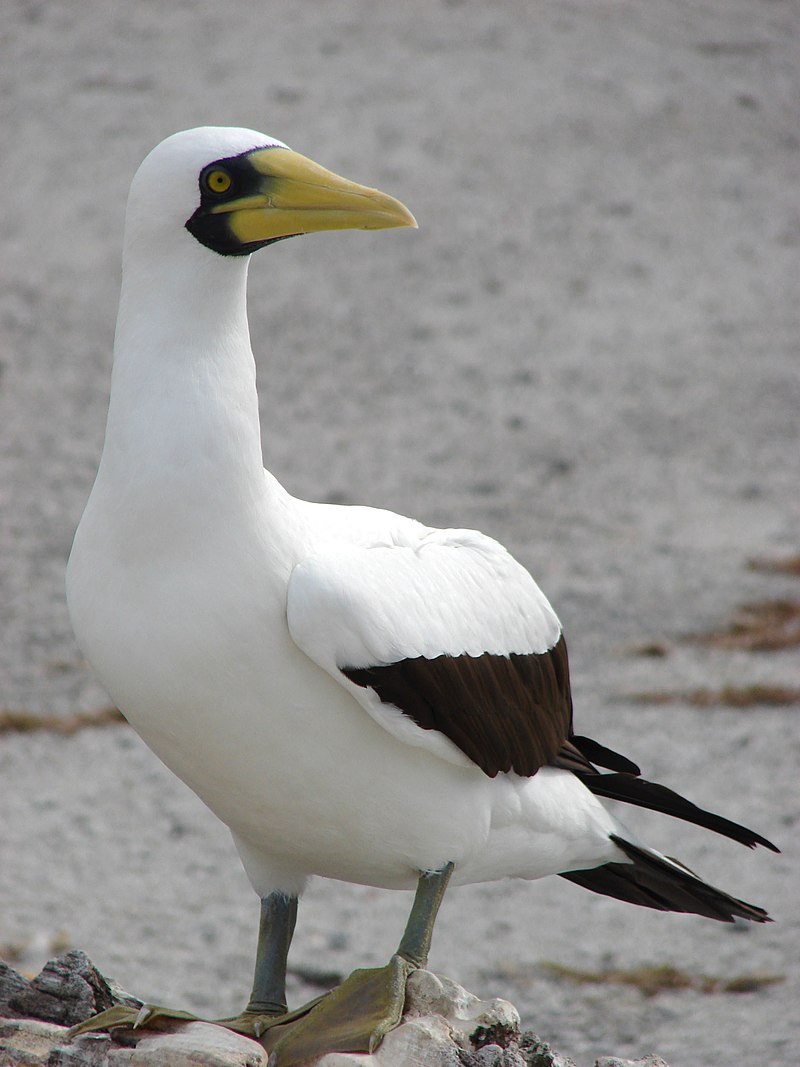
The Masked Booby is a large seabird belonging to the booby and gannet family. It was first described by French naturalist René-Primevère Lesson in 1831, making it one of six species of boobies within its genus Sula.
It has an impressive aerodynamic body shape with pale grey or white plumage on its head and neck, while the rest of its body is blackish brown.
Its wingspan can reach up to 1 metre wide. The bill is yellowish and pointed at the end, whilst they have bright blue skin around their eyes – this is why they are also known as ‘blue-faced’ boobies.
They use their strong wings for soaring over oceans in search of fish which makes them excellent fishers who feed mainly on flying fish near tropical waters but can occasionally be found off coasts in temperate regions too.Scientific classification:
| Kingdom | Animalia |
| Phylum | Chordata |
| Class | Aves |
| Order | Suliformes |
| Family | Sulidae |
| Genus | Sula |
| Species | S. dactylatra |
Also Featured In: Mauritius birds, Birds that Live in the Ocean
31. Collared Plover
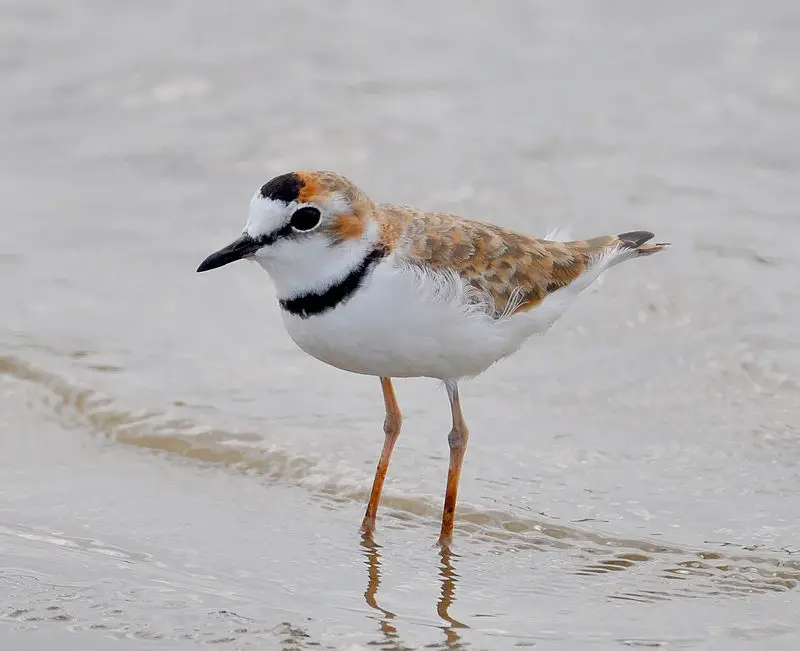
The Collared Plover is a small shorebird found along coasts and riverbanks of the tropical to temperate Americas, from central Mexico down to Chile and Argentina.
This plover measures 18 cm in length with an average weight of 35g; it has brown upperparts contrasting with white underparts all year round.
The adult plumage shows a black breast patch that can be seen clearly when they fly away or take off.
Although their population is decreasing due to habitat destruction, these birds have adapted well by learning how to live near human settlements where food sources are more plentiful.
They feed on insects, larvae, worms and other invertebrates while searching for them among mudflats, beaches or riversides.Scientific classification:
| Kingdom | Animalia |
| Phylum | Chordata |
| Class | Aves |
| Order | Charadriiformes |
| Family | Charadriidae |
| Genus | Charadrius |
| Species | C. collaris |
Also Featured In: Barbados Birds, Common Margarita Island Birds
32. Stilt Sandpiper
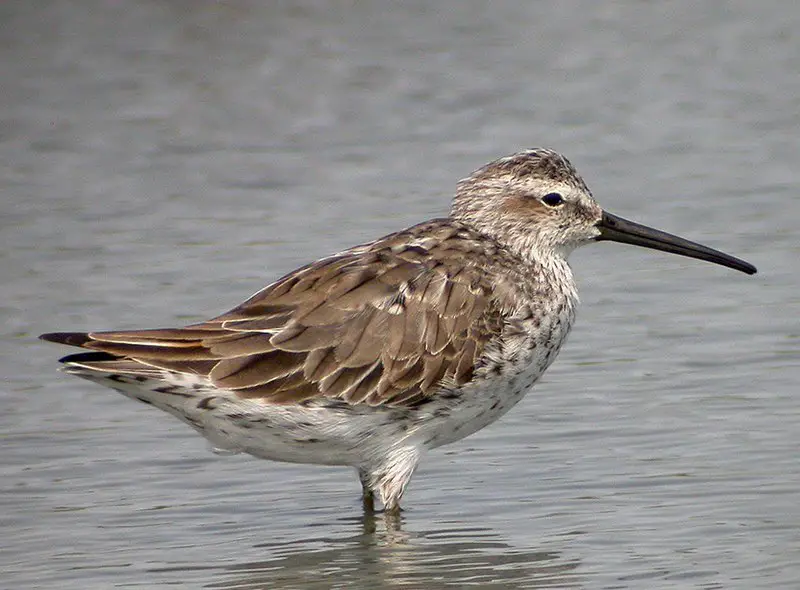
The Stilt Sandpiper (Calidris himantopus) is a small shorebird with ancient Greek origins. It has grey-coloured feathers, and its scientific name is derived from the terms “strap foot” or “thong foot”.
This bird bears some resemblance to smaller calidrid sandpipers, also known as ‘stints’. Through recent DNA sequence information, it was found that this species of birds are closely related to other wading shorebirds such as curlews and godwits.
They can usually be seen along the edges of rivers and creeks in shallow waters where they feed on aquatic insects like beetles, flies, mayflies etc., which makes them an important part of their ecosystem’s food chain.
The stilt sandpiper population appears to have been stable over time but further research needs to be done in order for us to understand more about this unique species.Scientific classification:
| Kingdom | Animalia |
| Phylum | Chordata |
| Class | Aves |
| Order | Charadriiformes |
| Family | Scolopacidae |
| Genus | Calidris |
| Species | C. himantopus |
Also Featured In: Saint Lucia Birds, British Virgin Islands Birds You Need to See
33. Yellow-Crowned Night Heron
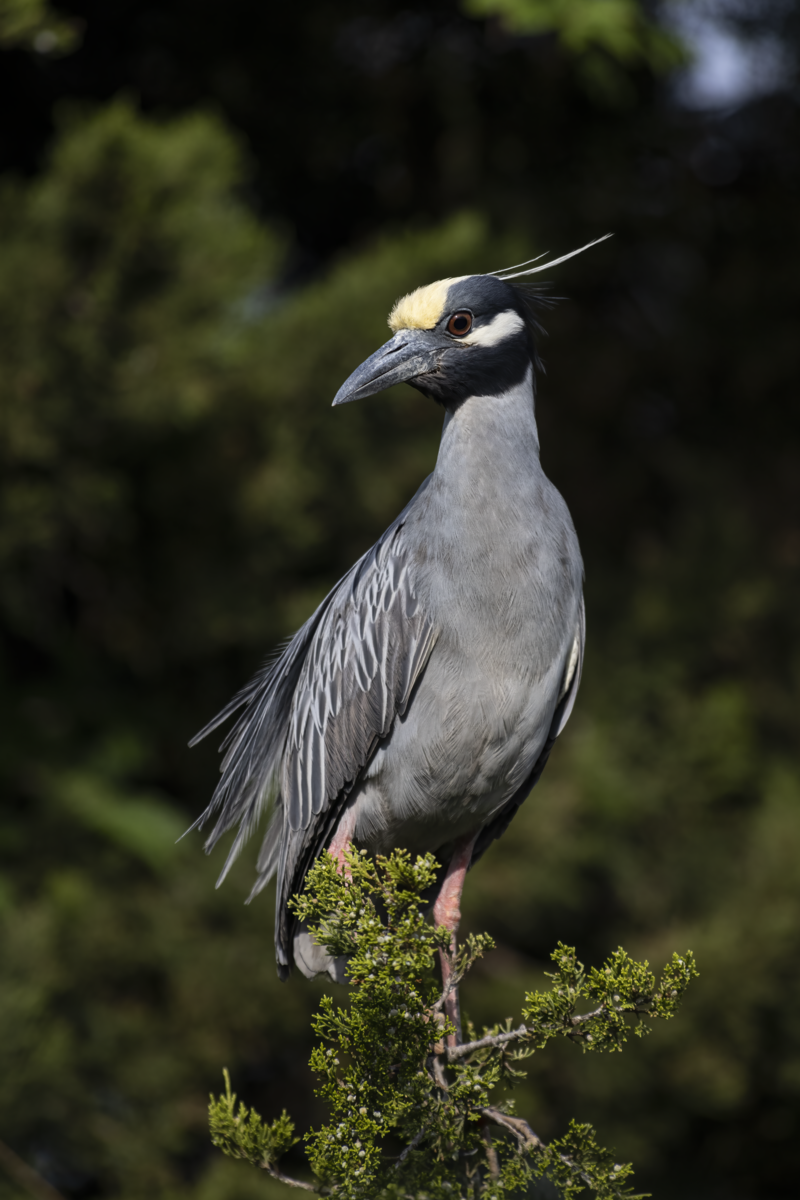
The Yellow-crowned night heron is a beautiful and unique species of bird native to the Americas. It has distinctive yellow crowns on its head, making it easy to identify among other herons.
These birds are also larger than most other types of herons, reaching up to 70 cm in length and 850 g in weight.
They usually feed on small fish or crustaceans while wading through shallow waters with their long legs.
The yellow-crowned night heron can be found near marshes or lakes during breeding season when they will build nests made from twigs high above the ground for protection against predators like raccoons and foxes.
This majestic bird is an important part of wetland ecosystems as it helps keep populations of smaller aquatic animals balanced by preying upon them.Scientific classification:
| Kingdom | Animalia |
| Phylum | Chordata |
| Class | Aves |
| Order | Pelecaniformes |
| Family | Ardeidae |
| Genus | Nyctanassa |
| Species | N. violacea |
Also Featured In: Bermuda birds, Flight Birds You Should Know
34. Least Grebe
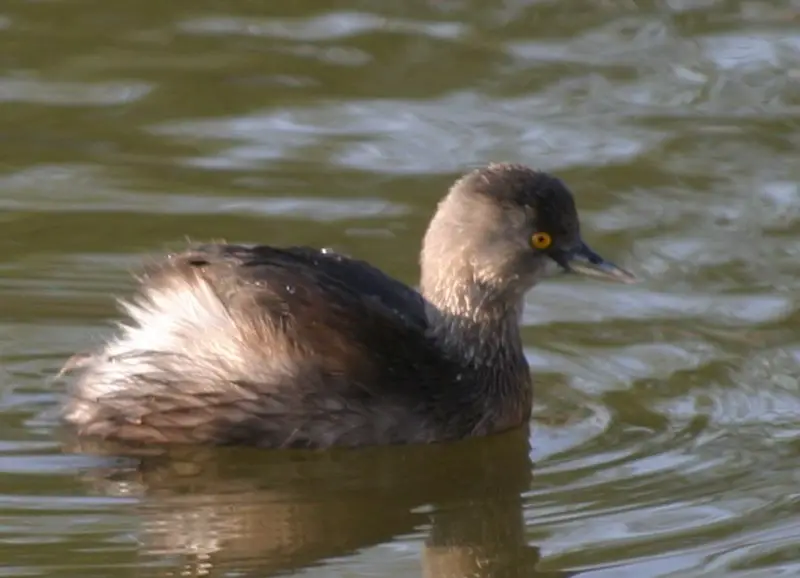
The Least Grebe is the smallest member of the grebe family and can be found in North, Central and South America. It measures around 21-27 cm long with a weight of 112-180 g.
Its range extends from southwestern United States to Argentina as well as Trinidad, Tobago, Bahamas and Greater Antilles.
The bird has an interesting plumage which varies depending on its subspecies; it may have dark brown upperparts or rusty back feathers along with whitish underparts having buff spots near the throat area.
In addition to this its neck has black streaks while head may be grey or reddish brown.
This species feeds mainly on small aquatic invertebrates like insects larvae , crustaceans etc., but also eats fish occasionally when available.
Breeding season for least grebes occurs during summer months between April -July where they build floating nests among reeds in shallow water bodiesScientific classification:
| Kingdom | Animalia |
| Phylum | Chordata |
| Class | Aves |
| Order | Podicipediformes |
| Family | Podicipedidae |
| Genus | Tachybaptus |
| Species | T. dominicus |
Also Featured In: Cayman Islands birds,
35. White-Tipped Dove
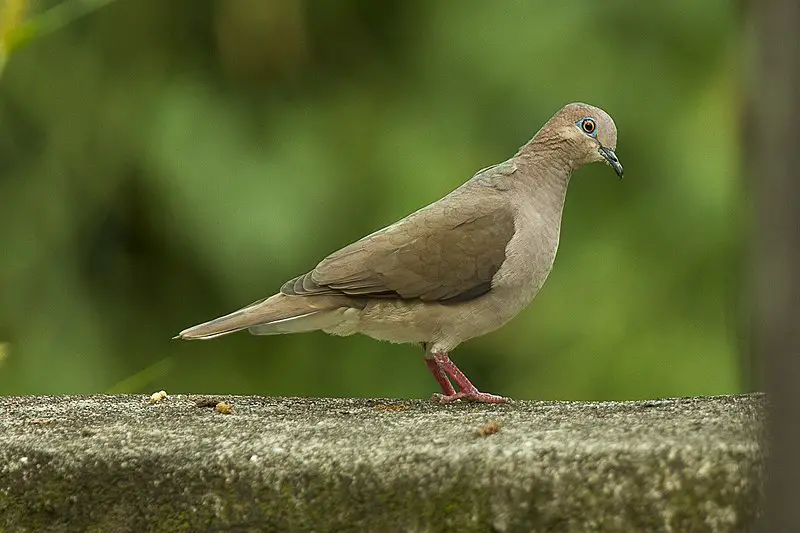
The White-tipped Dove is a majestic bird found in tropical areas of the New World, from southern Texas and Mexico all the way to western Peru and Argentina.
It carries with it an interesting scientific name: Leptotila verreauxi, named after French naturalists Jules and Edouard Verraux.
This species also breeds on offshore islands along northern South America, including Trinidad.
It has distinctive white tips on its wings which makes them easily identifiable while they are flying as well as when perched.
They have grayish brown feathers overall that helps camouflage them amongst trees or foliage making them difficult to spot otherwise.
The males tend to be slightly larger than females but other than that there isn’t much difference between their appearance aside from courtship rituals where both sexes will bow together for recognition before mating season starts.Scientific classification:
| Kingdom | Animalia |
| Phylum | Chordata |
| Class | Aves |
| Order | Columbiformes |
| Family | Columbidae |
| Genus | Leptotila |
| Species | L. verreauxi |
Also Featured In: Doves Birds, Birds You’ll Find in South Texas
36. Bat Falcon
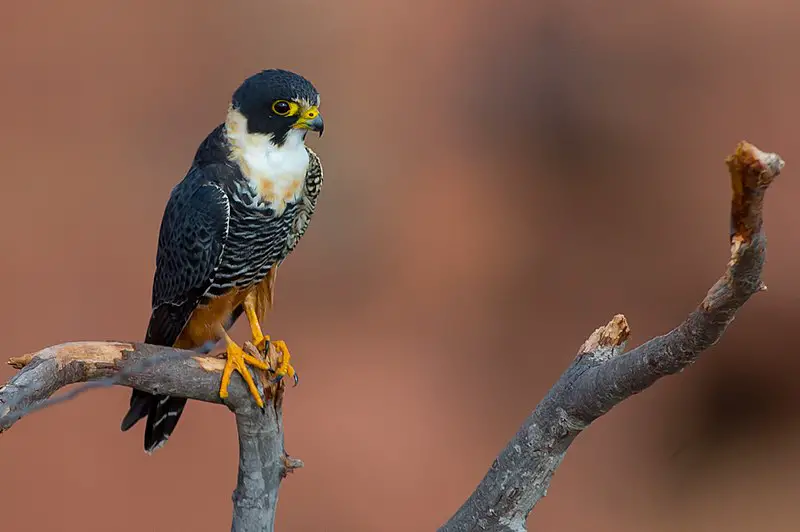
The Bat Falcon is a small falcon found in Mexico, Central and South America, as well as Trinidad. It was previously known as Falco albigularis but has since been renamed to its current name.
This bird of prey looks similar to the Orang-utan with its brownish-gray plumage and bright blue cere on top of their beaks. They are generally around 9 inches long with a wingspan reaching up to 20 inches across.
The Bat Falcons prefer open savanna or woodland habitats where they can hunt for insects or small birds during the day.
These birds rely heavily on flying insect populations which makes them vulnerable when these numbers drop due too environmental changes such climate change making it important that we protect this species from further endangerment by preserving suitable habitat types so they can continue living there happily.Scientific classification:
| Kingdom | Animalia |
| Phylum | Chordata |
| Class | Aves |
| Order | Falconiformes |
| Family | Falconidae |
| Genus | Falco |
| Species | F. rufigularis |
Also Featured In: Falcons Species, Puerto Vallarta Birds You Should Know
37. Bumblebee Hummingbird
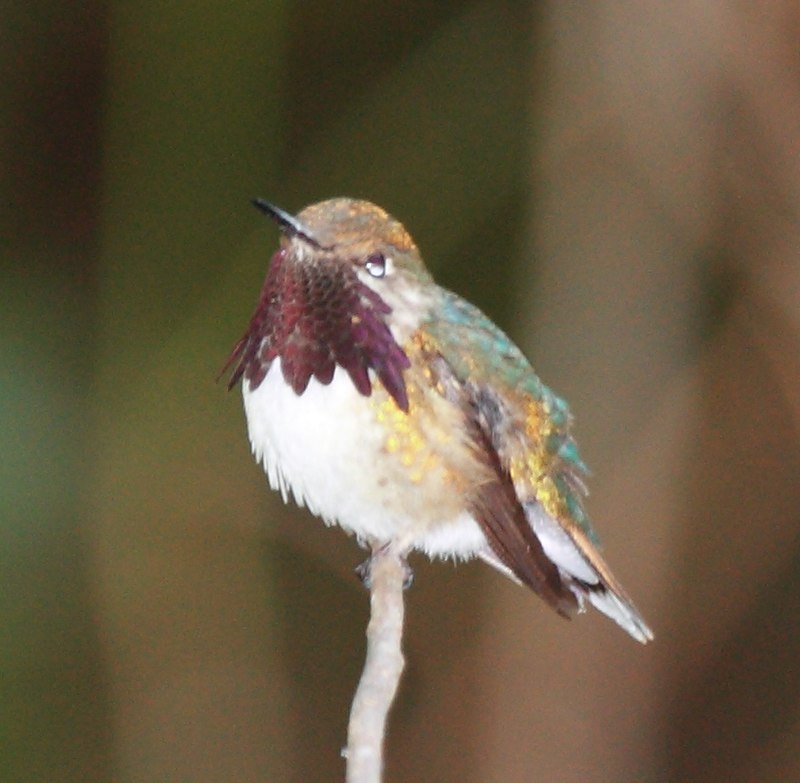
The Bumblebee Hummingbird is a species of hummingbird native to Mexico, but can sometimes be found as far away as the United States. It belongs to the Mellisugini tribe and Trochilinae subfamily.
This tiny bird has an average length of 2 inches and weighs only about 0.056 ounces. The beautiful plumage consists of metallic green upperparts with white underparts, topped off by a reddish-orange throat patch on males or yellowish-green for females.
They have long wings which allow them to fly quickly in search of nectar from flowers and small insects like aphids for protein sources during breeding season from April through August each year.Scientific classification:
| Kingdom | Animalia |
| Phylum | Chordata |
| Class | Aves |
| Order | Apodiformes |
| Family | Trochilidae |
| Genus | Selasphorus |
| Species | S. heloisa |
Also Featured In: Hummingbirds Species,
38. Greater Yellowlegs
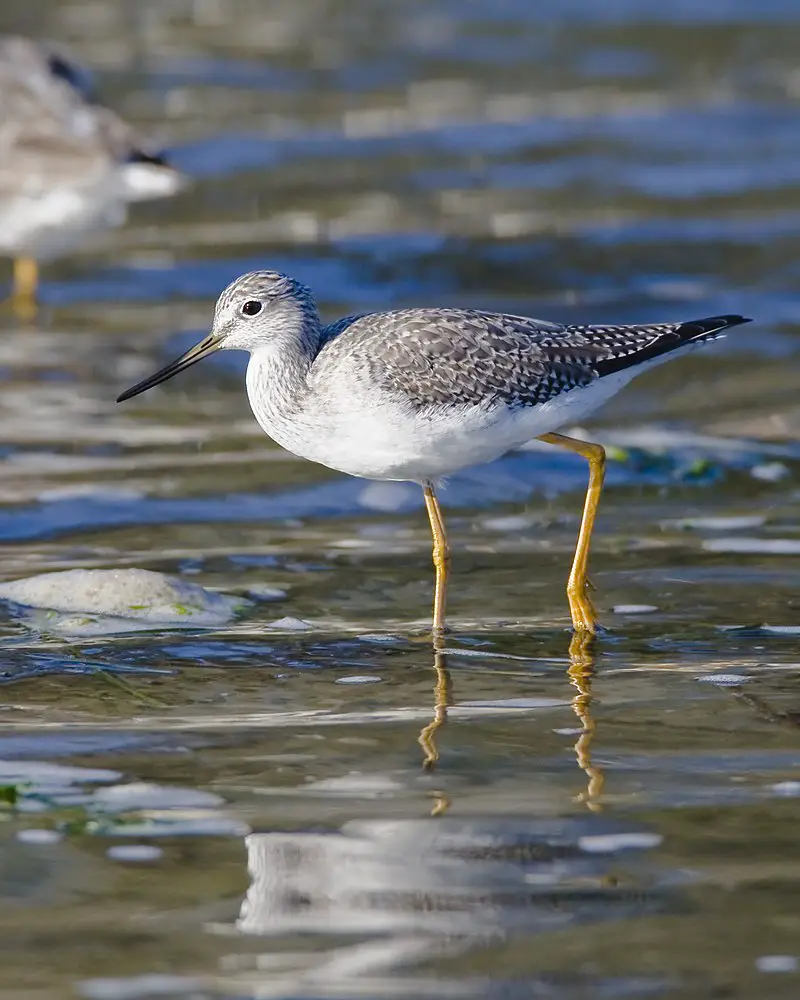
The Greater Yellowlegs is a large shorebird found in the family Scolopacidae. It nests mainly in central Canada and south Alaska, while wintering in southern North America, Central America, West Indies and South America.
The bird was formally described by German naturalist Johann Friedrich Gmelin as part of his revision to Carl Linnaeus’s Systema Naturae.
It has long yellow legs which sets it apart from other birds of its kind; when disturbed or alarmed they will flash these bright-colored limbs about wildly.
Its diet consists mostly of insects like flies, beetles, grasshoppers and dragonflies although aquatic invertebrates are also eaten on occasion.
These birds have adapted well to human habitation near shallow marshes or mudflats with plenty of food sources for them to feed upon making them an easier species for people who love bird watching.Scientific classification:
| Kingdom | Animalia |
| Phylum | Chordata |
| Class | Aves |
| Order | Charadriiformes |
| Family | Scolopacidae |
| Genus | Tringa |
| Species | T. melanoleuca |
Also Featured In: birds of Delaware, Wetlands Birds You Should Know
39. Montezuma Quail
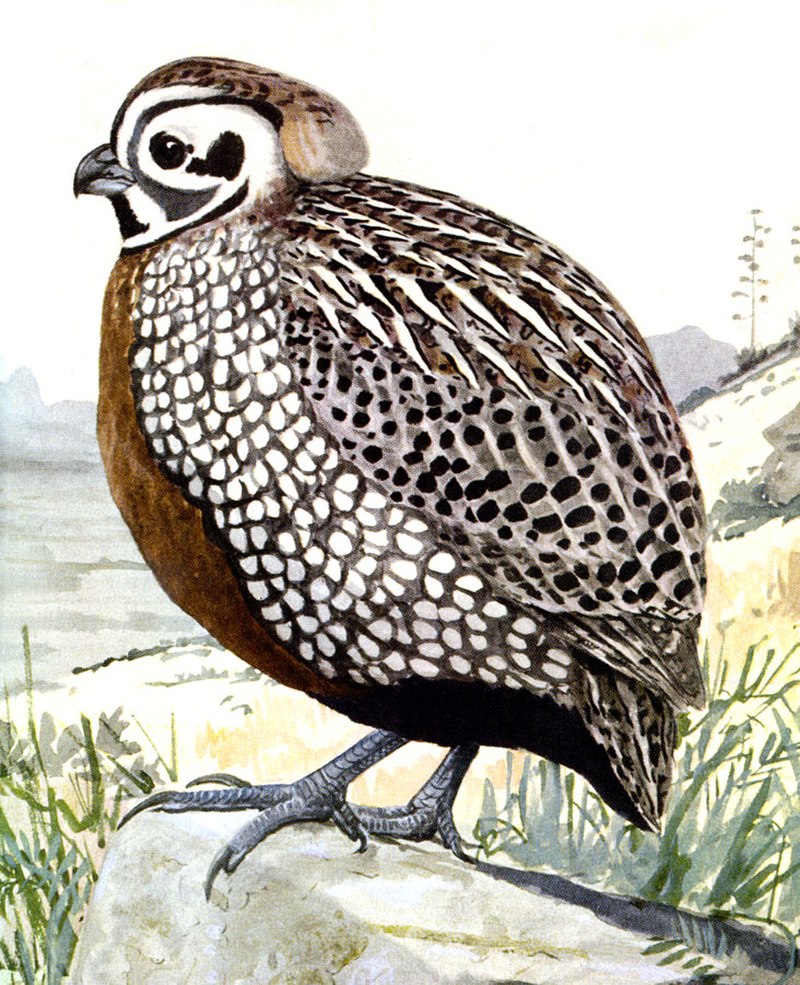
The Montezuma quail, also known as Mearns’s quail, the harlequin quail and fool quail due to its behavior is a stubby New World bird found in Mexico and some parts of the United States.
It was formally described by Irish zoologist Nicholas Aylward Vigors under the binomial name Ortyx montezumae in 1830.
This small secretive bird has striking patterning on male birds which gives it another common name – Harlequin Quails.
They inhabit deserts, grasslands or scrub vegetation for shelter but are shy and difficult to spot even when calling out their distinctive raspy call during mating season.
These birds feed mainly on insects such as beetles, ants along with seeds and other plant matter making them an important part of maintaining healthy ecosystems where they live.Scientific classification:
| Kingdom | Animalia |
| Phylum | Chordata |
| Class | Aves |
| Order | Galliformes |
| Family | Odontophoridae |
| Genus | Cyrtonyx |
| Species | C. montezumae |
Also Featured In: birds of Arizona, Birds that Live in Arizona Desert
40. Least Sandpiper
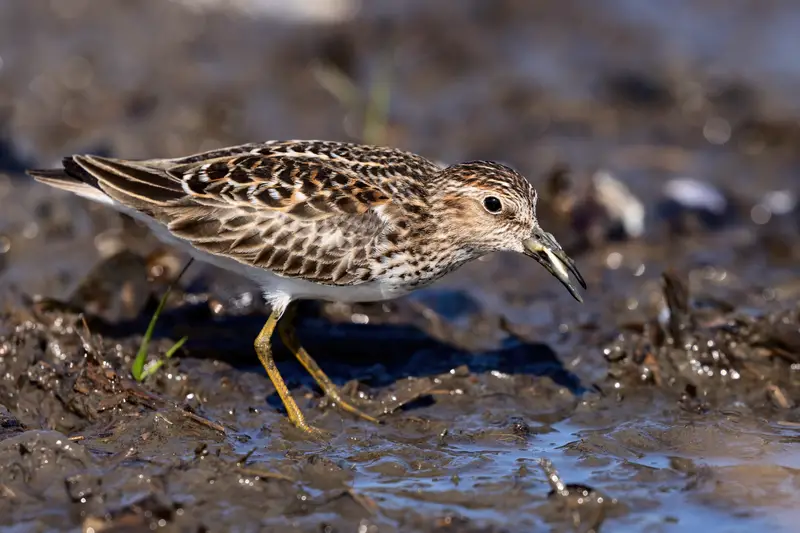
The Least Sandpiper is a shorebird that holds the title for being the smallest of its kind. Its Ancient Greek genus name, kalidris or skalidris, referred to grey-colored waterside birds.
The breed’s brown feathers with dark brown streaks, white underside, greenish legs, and short, thin, dark bill characterize adult Least Sandpipers.
The Medieval Latin name of the species, minutilla, further describes the breed’s tiny size.
These birds are known to inhabit shallow water marshes and mudflats during the summertime, and they migrate to coasts during the winters.
Least Sandpipers mainly feed on insects and small crustaceans, often by running and pecking in shallow water or mud.
Despite their small size, these birds travel great distances during migration, making impressive journeys from their breeding and wintering grounds.Scientific classification:
| Kingdom | Animalia |
| Phylum | Chordata |
| Class | Aves |
| Order | Charadriiformes |
| Family | Scolopacidae |
| Genus | Calidris |
| Species | C. minutilla |
Also Featured In: Most Common Lake Birds, Birds in Pacific Northwest
41. Western Sandpiper
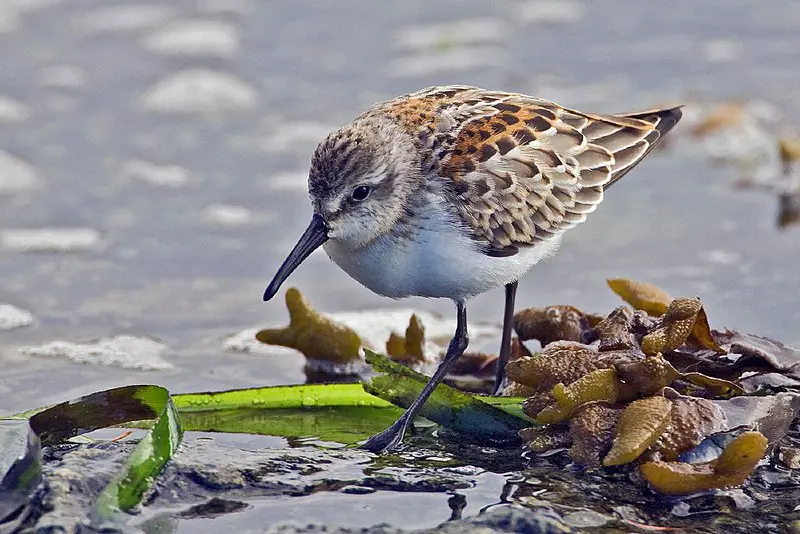
The Western sandpiper is a small shorebird found in North America. Its genus name, Kalidris, comes from the Ancient Greek term used by Aristotle for some grey-colored waterside birds.
The species name, mauri, is named after Italian botanist Ernesto Mauri. This species is one of the most abundant shorebirds in North America, with a population in the millions. Western sandpipers have dark legs and a short, straight bill.
They are often seen running quickly along the shorelines, probing the sand for insects and small crustaceans.
During breeding season, they nest in the Arctic tundra, and during migration, they can be found on mudflats and beaches along the Pacific Coast as well as inland shallow freshwater wetlands.Scientific classification:
| Kingdom | Animalia |
| Phylum | Chordata |
| Class | Aves |
| Order | Charadriiformes |
| Family | Scolopacidae |
| Genus | Calidris |
| Species | C. mauri |
Also Featured In: Birds that Live in San Francisco Bay Area, Estuaries Birds
42. Citreoline Trogon
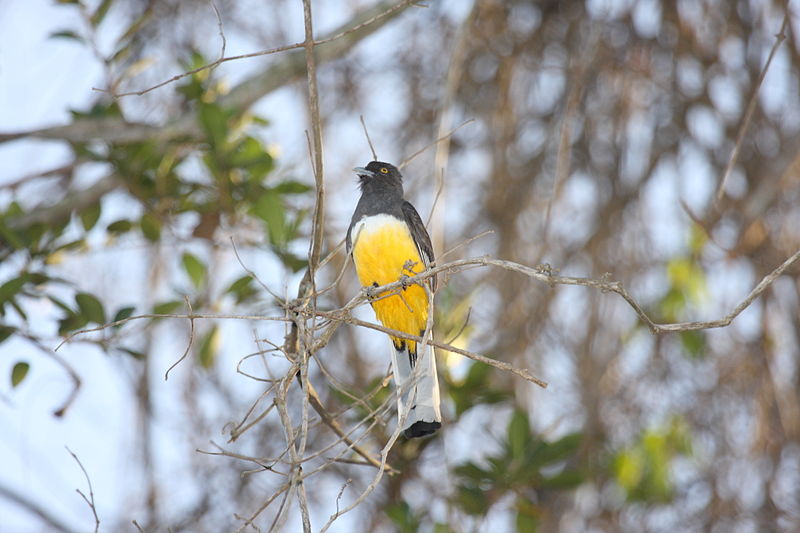
The Citreoline trogon bird is a species of bird in the Trogonidae family. It is found only in Western Mexico and has a vast estimated distribution size.
This has led to the IUCN classifying the species as least concern regarding conservation concerns, and its population trend as stable.
The bird has been studied as an ecosystem engineer, but there is not much other knowledge available about this species.Scientific classification:
| Kingdom | Animalia |
| Phylum | Chordata |
| Class | Aves |
| Order | Trogoniformes |
| Family | Trogonidae |
| Genus | Trogon |
| Species | T. citreolus |
Also Featured In: Common Birds of Guerrero, Birds that Live in Jalisco Birds
43. Wilson’s Plover
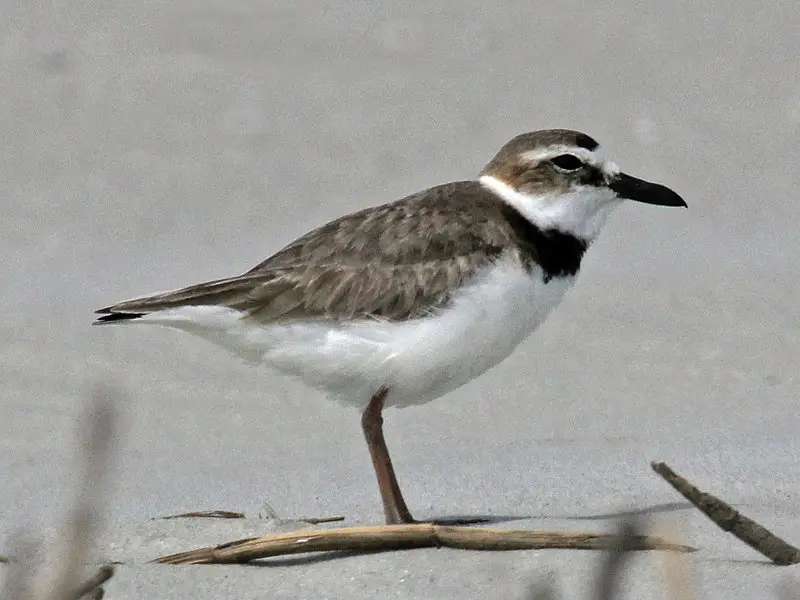
Wilson’s plover is a bird belonging to the Charadriidae family. The species was named after the ornithologist Alexander Wilson by his friend George Ord.
This small bird is typically found along the coasts of the Americas and breeds on both sides of the equator. Its range extends northward, including much of the U.S.
eastern seaboard and the Pacific coast of Mexico. Wilson’s plover is a coastal wader that loves to inhabit sandy and rocky shores, beaches, and salt marshes. They feed on crustaceans, insects, and other small creatures found near the shoreline.
This bird’s male and female have a similar appearance, with brownish-grey upperparts and white underparts. They are known to fiercely defend their nests and young against predators.
The Wilson’s plover is a unique bird species that plays a significant role in the coastal ecosystem.Scientific classification:
| Kingdom | Animalia |
| Phylum | Chordata |
| Class | Aves |
| Order | Charadriiformes |
| Family | Charadriidae |
| Genus | Charadrius |
| Species | C. wilsonia |
Also Featured In: Great Abaco Island Birds, Winged Marvels of St Martin’s: A Bird Enthusiast’s Delight
44. Red-Billed Pigeon
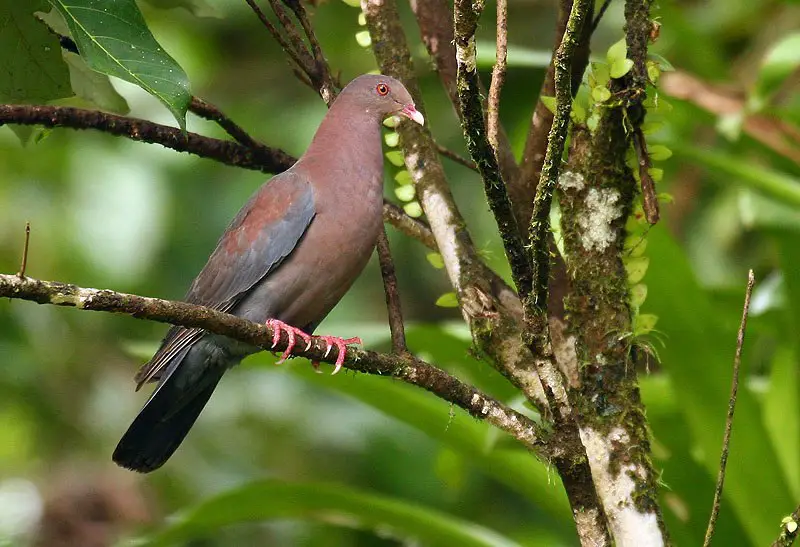
The Red-billed pigeon is a sturdy, large bird that inhabits southern Texas in the United States to the coasts and lowlands of Central America.
This species belongs to a clade of Patagioenas that typically lack iridescent display plumage.
Red-billed pigeons are commonly found in wooded areas, where they gather in flocks to feed on fruit and grains.
They are also known for their distinct cooing call, which is often heard echoing through the forest canopies.
Although not currently listed as threatened, habitat destruction and hunting pose a significant threat to the Red-billed pigeon population.
Conservation efforts could help to protect this valuable bird species for future generations to appreciate.Scientific classification:
| Kingdom | Animalia |
| Phylum | Chordata |
| Class | Aves |
| Order | Columbiformes |
| Family | Columbidae |
| Genus | Patagioenas |
| Species | P. flavirostris |
Also Featured In: Birds that You’ll Find in Chiapas, Birds that Live in Tabasco
45. Lesser Roadrunner
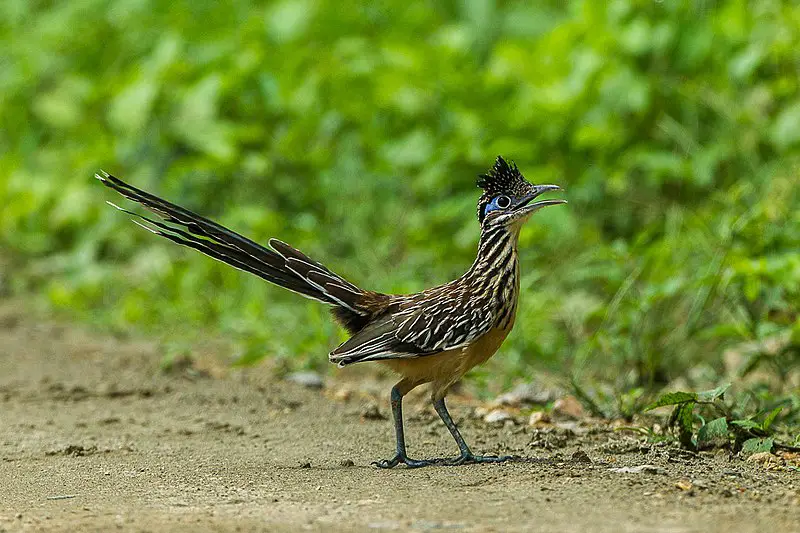
The Lesser Roadrunner bird is a member of the cuckoo family, measuring up to 51 cm long with a tail length of about 24 cm. The bird is slender and has long legs, earning it the Latin name “swift earth-cuckoo”.
Found in Mesoamerica, it is one of two species in the genus Geococcyx, the other being the Greater Roadrunner.
The Lesser Roadrunner is known for its swift movements and is an excellent runner, running at a speed of 24 km/h.
The bird has a pale brown body with dark stripes, making it well camouflaged in its habitat. It primarily feeds on insects, small reptiles, and rodents.
Despite its name, the Lesser Roadrunner is by no means “lesser” in its abilities and provides an important ecological role in its ecosystem as a predator and seed-disperser.Scientific classification:
| Kingdom | Animalia |
| Phylum | Chordata |
| Class | Aves |
| Order | Cuculiformes |
| Family | Cuculidae |
| Genus | Geococcyx |
| Species | G. velox |
Also Featured In: Most Common Birds Found in Nayarit,
46. Rose-Throated Becard
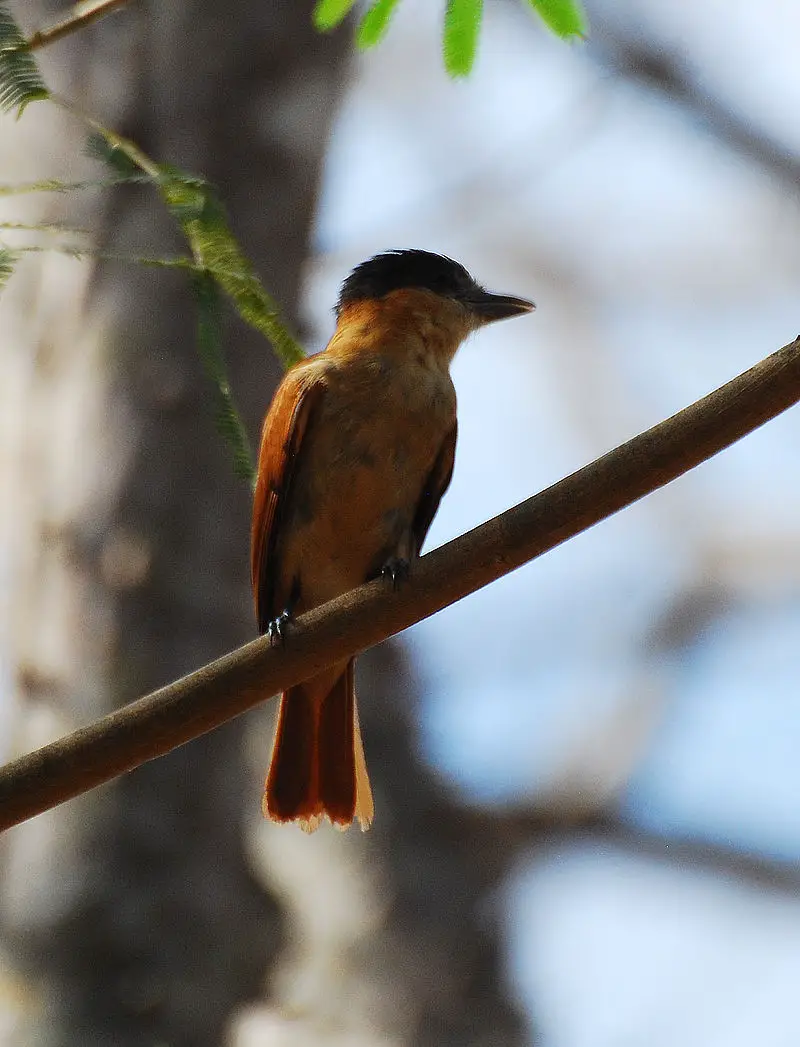
The rose-throated becard is a medium-sized bird belonging to the Tityridae family. Its scientific name is Pachyramphus aglaiae, and it was named after Aglaé Brelay.
Taxonomists have debated the classification of this bird for a long time, with many suggesting that it belongs in the Cotingidae or Tyrannidae family. However, recent evidence strongly supports its placement in the Tityridae family.
The rose-throated becard is known for its distinctive rose-colored throat and is a beautiful addition to the avian world. As a medium-sized bird, it is neither too big nor too small, making it easy to observe in its natural habitat.
Given its unique physical characteristics and status as a member of the Tityridae family, the rose-throated becard is an important bird for both birdwatchers and researchers to study.Scientific classification:
| Kingdom | Animalia |
| Phylum | Chordata |
| Class | Aves |
| Order | Passeriformes |
| Family | Tityridae |
| Genus | Pachyramphus |
| Species | P. aglaiae |
Also Featured In: Most Common Birds You’ll Find in Quintana Roo, Cozumel Birds You Didn’t Know
47. Mountain Trogon

The Mountain Trogon, also known as the Mexican Trogon, is a bird species found in Guatemala, Honduras, and Mexico. It was first described by William John Swainson in 1827.
This bird belongs to the Trogonidae family and is sexually dimorphic. The male has striking metallic green-colored feathers on its crown, nape, upper parts and chest, while the female has a duller coloration.
Mountain Trogons are known for their distinctive calls, which are often heard within their habitat. These birds are found in mountainous areas and have been spotted as vagrants in El Salvador.
Overall, the Mountain Trogon makes for a beautiful sight with its bright green feathers, and its unique appearance is sure to capture your attention.Scientific classification:
| Kingdom | Animalia |
| Phylum | Chordata |
| Class | Aves |
| Order | Trogoniformes |
| Family | Trogonidae |
| Genus | Trogon |
| Species | T. mexicanus |
Also Featured In: Most Common Birds in Michoacán,
48. Short-Tailed Hawk
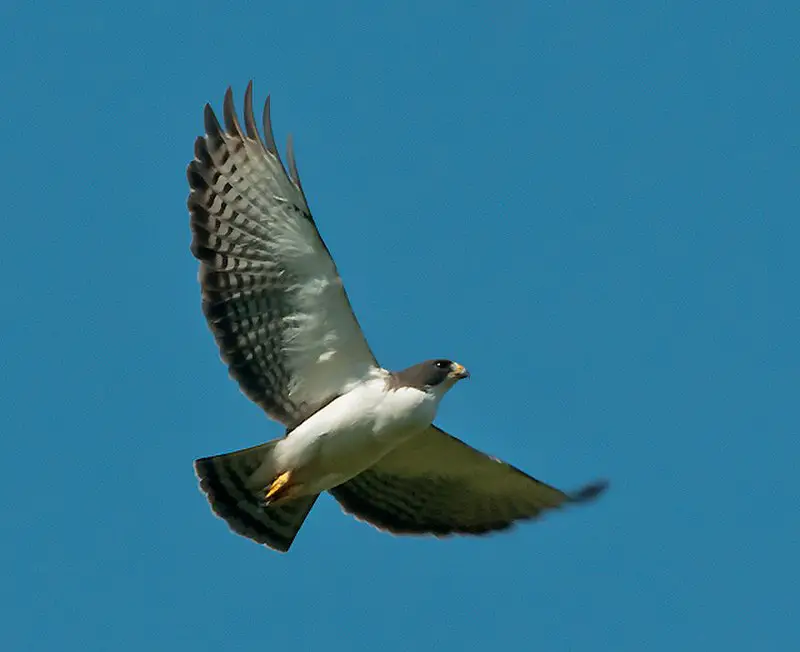
The Short-tailed hawk is a bird species belonging to the Accipitridae family found in North and South America, and is often called a “buteo” or “buzzard”.
Although referred to as a hawk, it is not a true hawk and is classified under the Buteo genus. Its close relative, the White-throated hawk, was previously considered part of the same species.
Known for its agility and sharp talons, the Short-tailed hawk is a skilled predator that feeds on small mammals, reptiles, and birds.
Its distinctive feature is its short tail, which aids in maneuverability while hunting in dense forests or open fields.
Due to habitat loss and other threats, the species has been designated as “near threatened” on the IUCN Red List.Scientific classification:
| Kingdom | Animalia |
| Phylum | Chordata |
| Class | Aves |
| Order | Accipitriformes |
| Family | Accipitridae |
| Genus | Buteo |
| Species | B. brachyurus |
Also Featured In: Birds That Live In Boca Grande, Birds You Should Know San Marco Island
49. Thick-Billed Kingbird
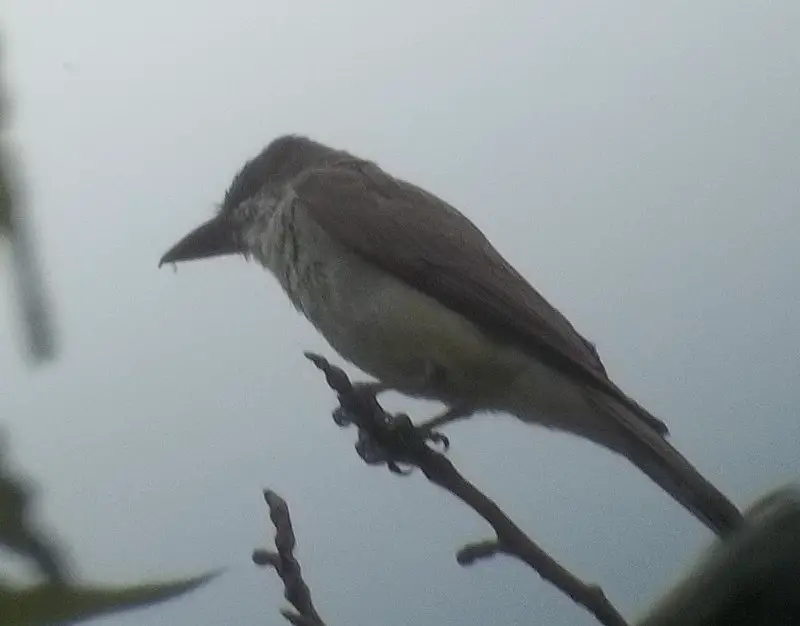
The Thick-billed kingbird is a member of the tyrant flycatchers family and is known for its large size.
They are found in southeastern Arizona and southwestern New Mexico in the USA and northern Sonora, Mexico.
They can also be spotted along the western and western-coastal regions in Mexico, extending to western Guatemala.
These birds are usually found in arid or semi-arid habitats. Their distinct feature is their thick beaks, which helps them to catch and eat insects.
They breed in these regions during the summer season, and their nests are built on cacti or other trees.
These birds are known to be aggressive in defending their nests and territories, and they aren’t afraid to confront larger birds or animals.
Despite their large size, they are incredibly agile and acrobatic while hunting prey.Scientific classification:
| Kingdom | Animalia |
| Phylum | Chordata |
| Class | Aves |
| Order | Passeriformes |
| Family | Tyrannidae |
| Genus | Tyrannus |
| Species | T. crassirostris |
50. Green-Fronted Hummingbird
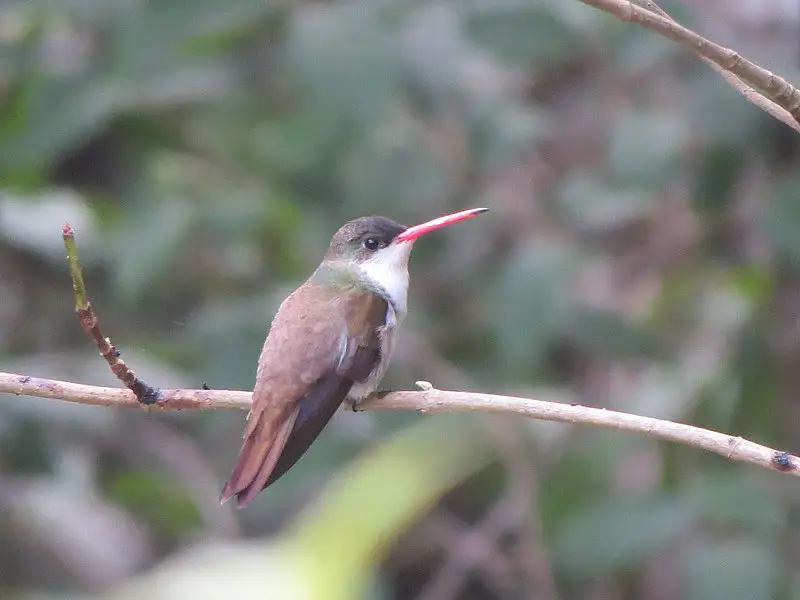
The Green-fronted hummingbird is a member of the Trochilini tribe found in Mexico and potentially Guatemala.
This species was once classified under the genus Amazilia, but a phylogenetic study showed that the genus was polyphyletic.
These hummingbirds have a distinctive green front and belong to the emerald hummingbird group.
They are known for their ability to hover mid-air while feeding on nectar from flowers. Their small size and vibrant colors make them a popular sight among birdwatchers.
While little is known about their specific behaviors, they are important pollinators and play a crucial role in maintaining the ecosystem’s balance.
The Green-fronted hummingbird’s habitat is under threat due to human activity, highlighting the importance of conservation efforts to protect this species and its environment.Scientific classification:
| Kingdom | Animalia |
| Phylum | Chordata |
| Class | Aves |
| Clade | Strisores |
| Order | Apodiformes |
| Family | Trochilidae |
| Genus | Ramosomyia |
| Species | R. viridifrons |
51. Dusky Hummingbird
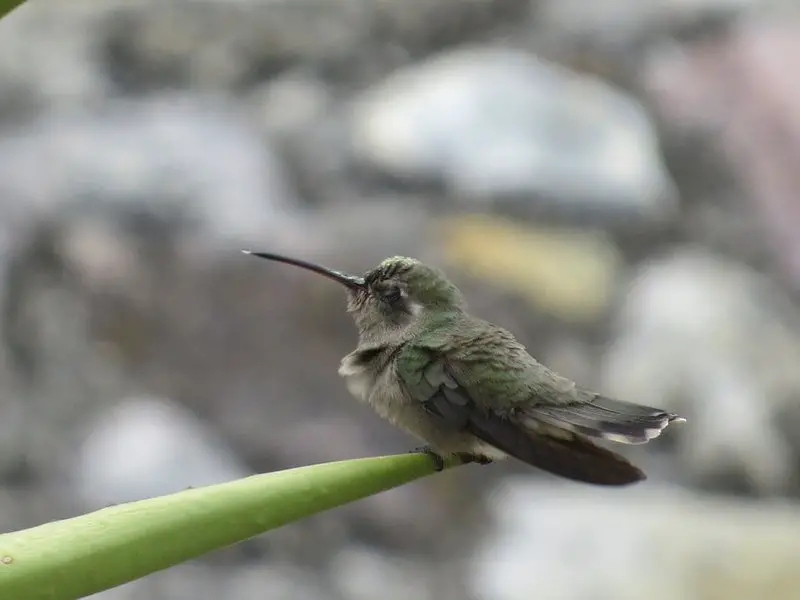
The dusky hummingbird is a bird species from the Trochilini tribe and subfamily Trochilinae. It is found solely in Mexico and was previously identified as a member of the Cynanthus genus.
Recent molecular studies led to its reclassification to the Phaeoptila sordida genus. As a hummingbird, it is known for its small size and rapid wing flapping, allowing it to hover and feed on nectar from flowers.
The dusky hummingbird has a distinctive dark plumage, hence its name, and is a favorite among birdwatchers.
Due to habitat loss, these birds have been classified as a species of special concern by Mexican authorities, and conservation efforts have been implemented to protect the dusky hummingbird and its natural habitat.Scientific classification:
| Kingdom | Animalia |
| Phylum | Chordata |
| Class | Aves |
| Clade | Strisores |
| Order | Apodiformes |
| Family | Trochilidae |
| Tribe | Trochilini |
| Genus | Phaeoptila Gould, 1861 |
| Species | P. sordida |